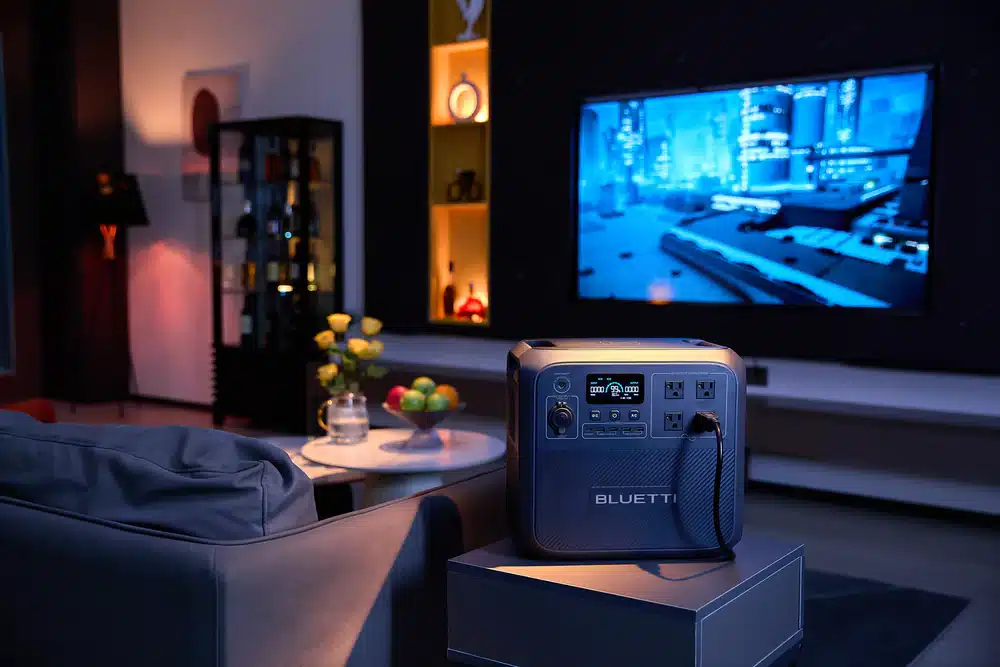The 9 Best Portable Power Stations [2025]: All Budgets
Looking for a power station small enough to carry but powerful enough to keep your essentials running?
Whether you’re prepping for storms, living the vanlife, or running camera gear at a remote shoot, a reliable power station is the difference between smooth, uninterrupted work and learning just how long you can live without coffee and Wi-Fi.
Some are tiny and ultra-portable, some are midsize all-rounders, and some are big, wheeled monsters built to run your house for days.
So which one is actually right for you? Which models are worth the cash, and which will leave you with buyer’s remorse?
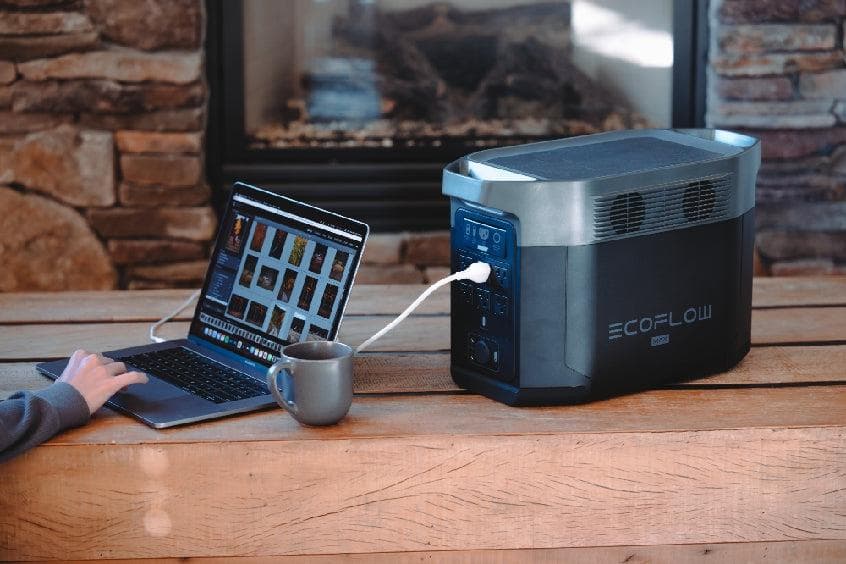
We tested the top portable power stations across real-world scenarios – from rooftop solar topping to fast AC recharges, UPS behavior, and actual appliance runtimes – and we picked the units that deliver where it counts.
Whether you want a grab-and-go camp battery, a compact UPS for your home office, or a wheeled workhorse for extended outages, we’ve got the best picks laid out so you can choose with confidence.
Plug in, let’s power up.
1. BEST OVERALL: EcoFlow DELTA 3 Plus
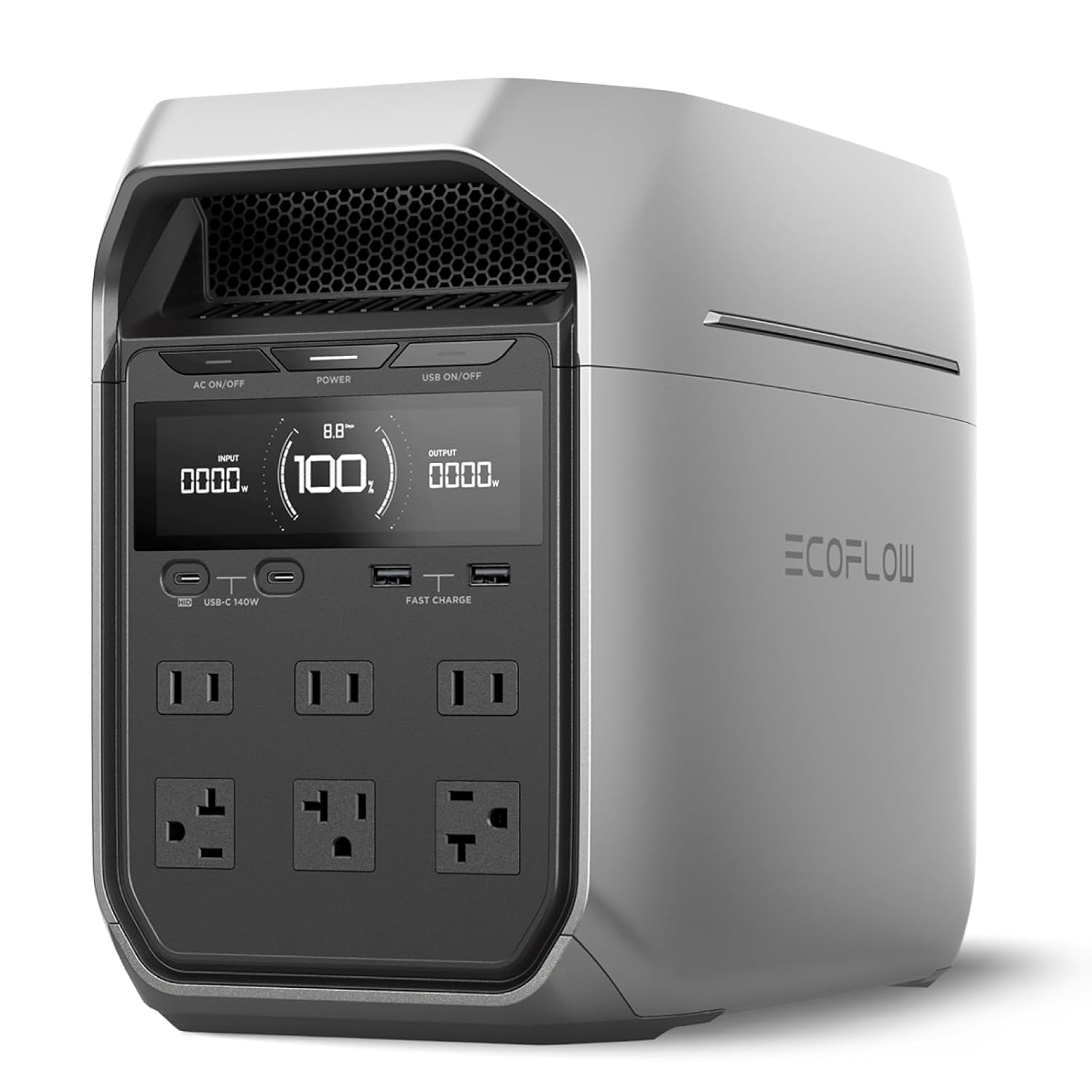
EcoFlow DELTA 3 Plus
EcoFlow built its name on fast‑charging solar generators, and the DELTA 3 Plus is the company’s sweet‑spot all‑rounder. You get a long‑life LFP battery at 1,024 Wh, a 1,800 W inverter that’ll cover most home and campsite loads, sub‑hour AC recharging, and a built‑in 10 ms UPS to keep sensitive gear from dropping when the lights blink.
It also grows with you, expanding to 5 kWh with a single extra battery. That combination makes it an easy default pick for backup, van life, and weekend power without lugging a giant unit.
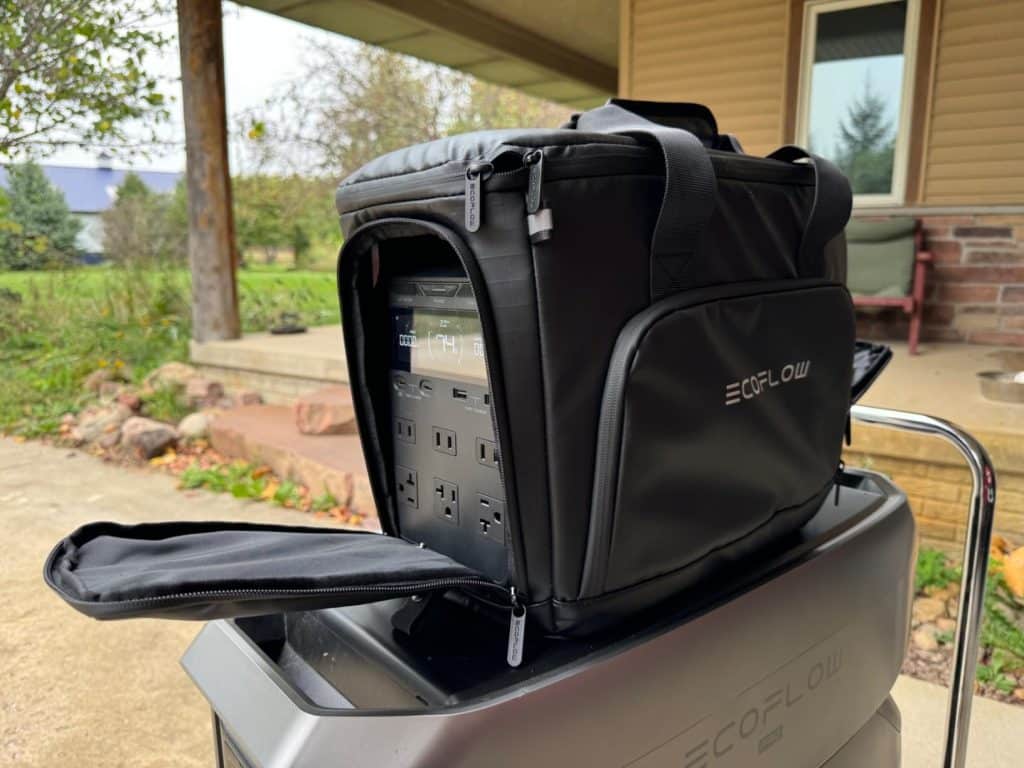
What We Like: There’s a lot to like here. First are the ridiculously fast top‑ups. Plug it into the wall and go 0–100% in about 56 minutes thanks to 1,500 W X‑Stream charging. In most independent testing, reviewers have matched that time. It’s the difference between “dead” and “ready for the evening” while you make lunch.
As far as the UPS goes, the DELTA 3 Plus switches over in roughly 10 ms, which is quick enough to keep routers, NAS boxes, CPAPs, and many PCs alive through a brief outage. If you plan to rely on it as a UPS, always test your exact setup.
The next thing that stood out to us, is it has the ports you actually want. Six AC outlets, two 140 W USB‑C, two USB‑A, a 12‑V car socket, and two DC5521 round out a 13‑port layout. The 140 W USB‑C alone makes it a great laptop hub without dragging bricks.
Indoors, it’s pretty quiet. Under 600 W of load, the unit targets about 30 dB, so it fades into background noise in a living room or tent.
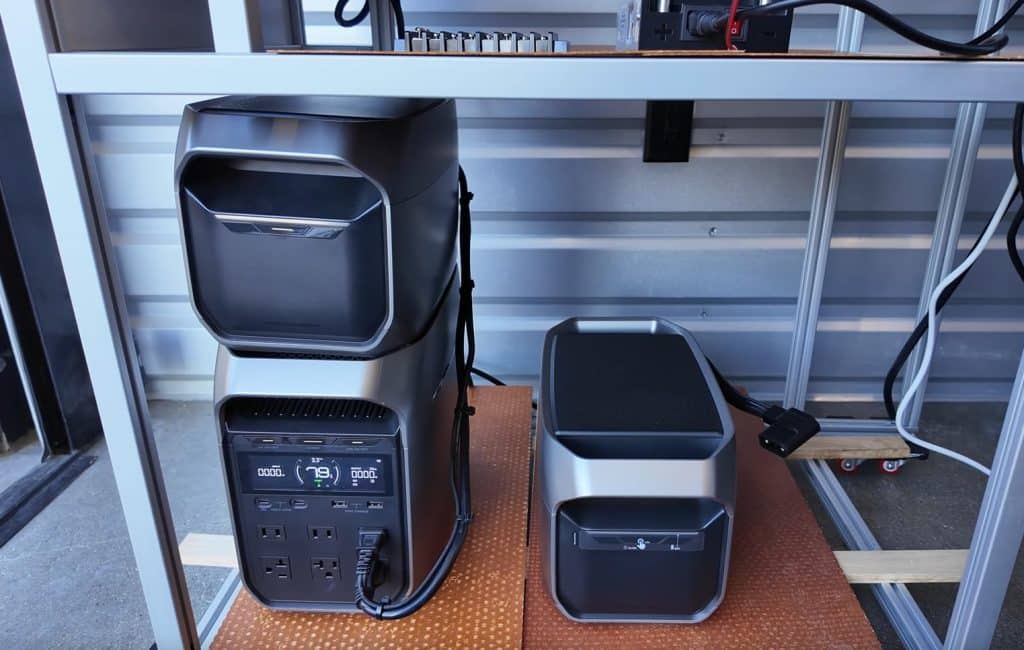
If you add an expansion battery, you can reach 2–5 kWh total, including compatibility with EcoFlow’s DELTA 3, DELTA 2/2 Max, or DELTA Pro 3 extra batteries. That keeps the base unit portable while giving you long‑runtime options later.
You also have flexible recharging. Two MPPT inputs (500 W each) accept up to 1,000 W of solar, there’s optional 800 W alternator charging for full car top‑ups in about 1.3 hours, and you can hybrid‑charge with AC + solar.
Another thing we like is the long service life and warranty. Third‑gen LFP cells are rated for roughly 4,000 cycles to 80% capacity, and EcoFlow backs the unit with a 5‑year warranty. It’s portable enough to carry at about 27.6 lbs. The dimensions are compact, and with built-in handles, it’s easy to move around.
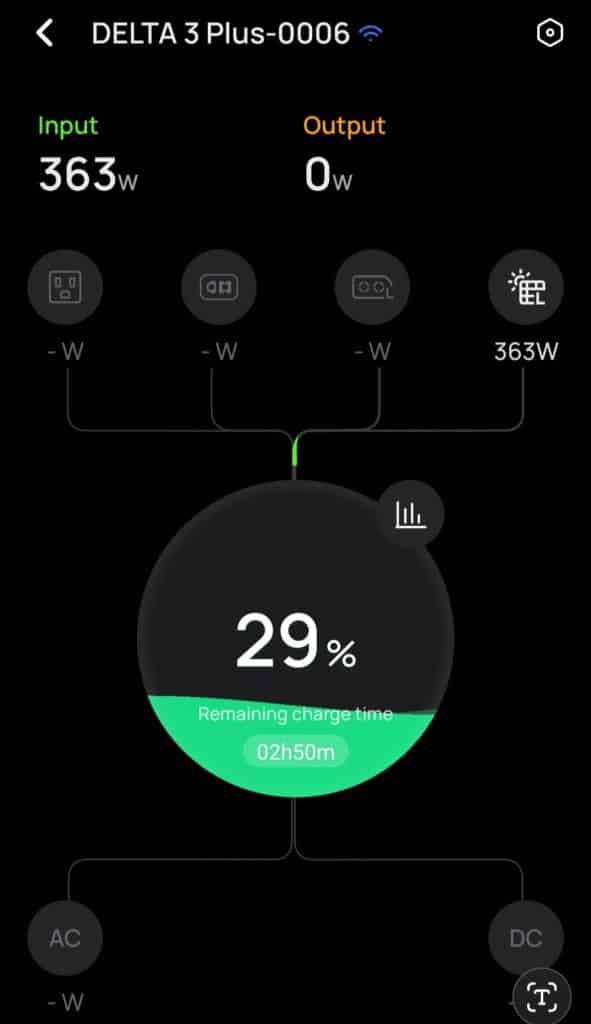
Last note – the app is useful. Remote control, time‑of‑use scheduling, and storm alerts make it easy to automate charging and keep tabs on the battery when you’re away.
Flaws but Not Dealbreakers: The base unit is 27.6 lb, but if you add the extra battery, it pushes the stack into “awkward to carry” territory. If you need roll‑around convenience, you’ll want a wheeled cart or a different form factor.
The UPS isn’t enterprise-grade. The 10 ms switchover is great for most home devices, but it’s still a standby UPS, not true online double‑conversion. Some users report mixed results with certain PC power supplies and automations, so verify your workload.
Solar has practical limits. Hitting the full 1,000 W requires two arrays and panels that fit the 11–60 V, 15 A per‑input window. Many 12‑V panels will need series wiring to land in that range.
Another drawback for us is that cloud/app quirks happen. EcoFlow’s ecosystem is broad and improving, but you’ll still see occasional cloud hiccups and flaky automations. It’s fine day‑to‑day, just avoid hinging mission‑critical workflows on it.
Bottom Line: If you want one power station that charges crazy fast, runs the essentials, keeps your network gear alive through blips, and can stretch to multi‑day runtime with an add‑on battery, the DELTA 3 Plus is the simplest “buy once, use everywhere” pick. It’s ideal for apartment backup, van and RV duty, event power, and weekend cabins where portability, UPS behavior, and quick top‑ups matter.
2. BEST BUDGET (ULTRA PORTABLE): EcoFlow RIVER 3
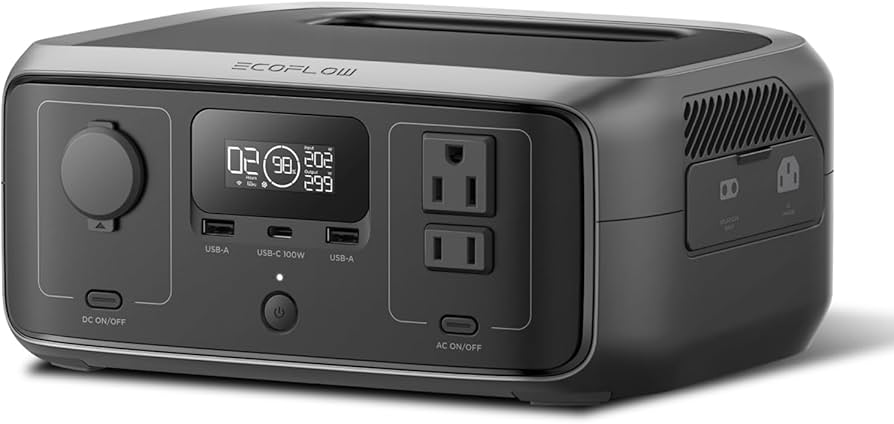
EcoFlow RIVER 3
EcoFlow’s RIVER 3 is the throw‑it‑in‑the‑bag power station that still feels like a real tool, not a toy. At around a quarter‑kilowatt of LFP storage and a 300‑watt inverter with 600‑watt X‑Boost, it’s built for phone‑to‑laptop duty, camera kits, routers, camp lights, and short stints on small appliances.
In EcoFlow’s lineup, it’s the lightest true power station beneath the larger RIVER 3 Plus/Max models, which step up output and capacity.
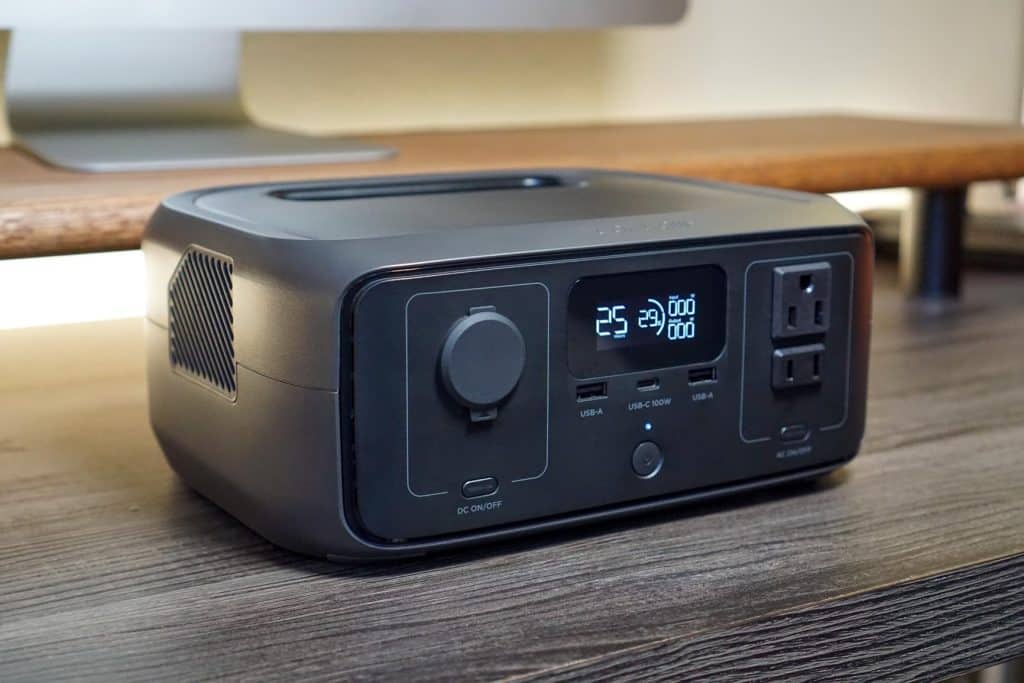
What We Like: At about 7.8 lb and roughly 10 × 8.3 × 4.4 in, the RIVER 3 fits in a daypack and tucks easily under a desk or van seat. You’re far more likely to bring this along than a 20‑ to 30‑lb box. It’s ultra portable.
You get a true 60‑minute wall recharge. Plug into AC and go 0–100% in about an hour thanks to a 320‑watt onboard charger. That makes it easy to top up over lunch.
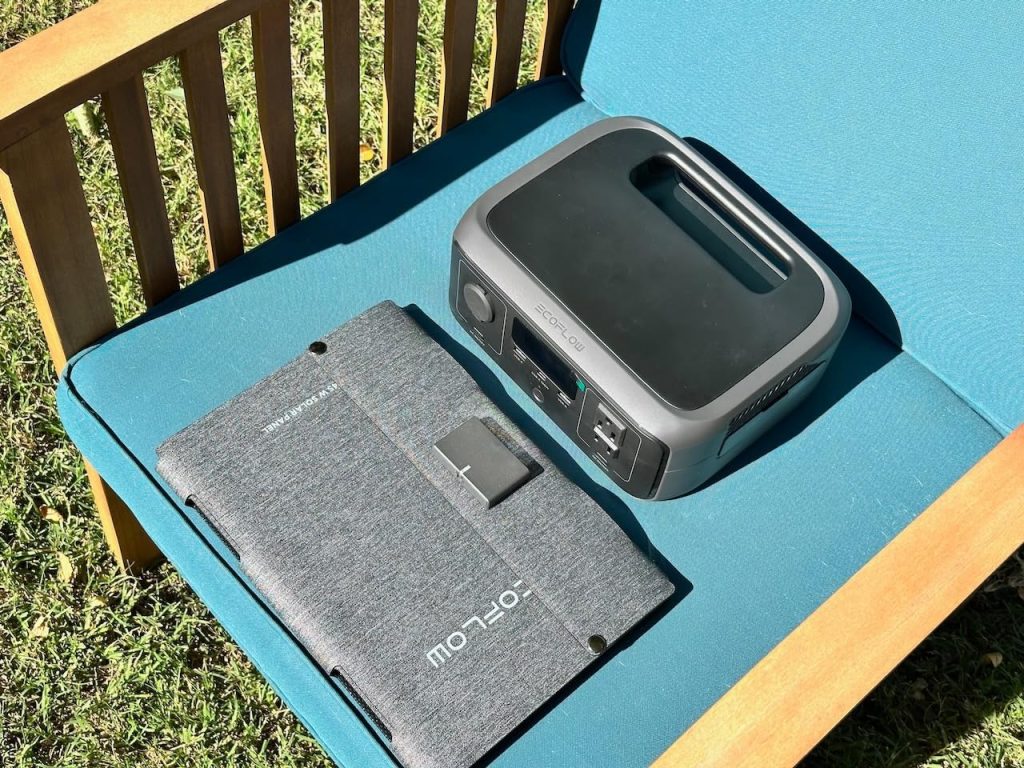
EcoFlow rates the unit at under 30 dB, and it feels it whisper‑quiet in practice. As a mini‑UPS, the RIVER 3 can auto‑switch power fast enough to keep routers, NAS boxes, or a desktop from dropping during brief blips. (Transfer time spec is under 20 ms on the base model.)
There’s a good port mix for small loads too. You get two AC outlets, one 100 W USB‑C, two USB‑A, and a 12‑volt car socket. For phones, tablets, cameras, and most ultraportable laptops, that’s everything you need without dongle gymnastics. Wi‑Fi/Bluetooth control in the EcoFlow app adds scheduling and charge‑rate control.
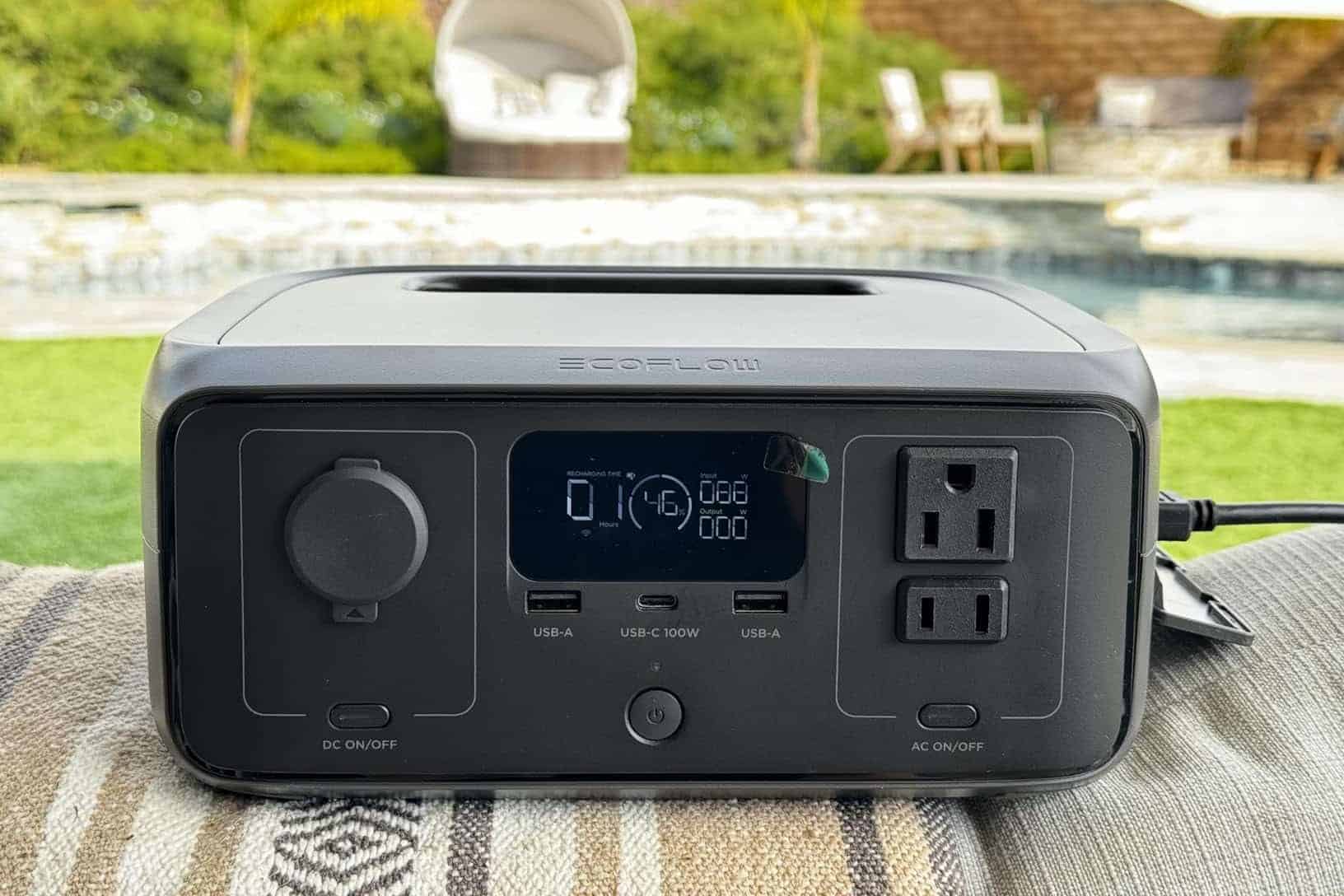
Lastly, it’s priced right if you’re buying your first power station. It’s the best budget option because it’s light, quick-charging, and capable of day-to-day tasks. If you’re new to portable power, this is an easy, low-risk starting point.
Flaws but Not Dealbreakers: It has a modest output ceiling, but I wouldn’t have huge expectations for a budget portable device like this. The 300‑watt inverter and 600‑watt X‑Boost are meant for light duty. X‑Boost prioritizes certain resistive loads; don’t expect it to run every appliance. If you regularly need 600 W continuous, the RIVER 3 Plus is the better fit.
Small battery = short runtimes on big devices. With ~245 Wh on tap, it’s ideal for phones, cameras, Wi‑Fi, lights, and brief laptop or small‑appliance use. For multi‑hour appliance runtime, you’ll want more capacity. (The Plus/Max variants bump to 286 Wh and 572 Wh, respectively.)
The solar input is limited. The RIVER 3 accepts up to about 110 W of solar, which is fine for top‑ups but not aggressive daylight refills. Expect roughly 2.5–3 hours in ideal sun with a compatible panel.
And the last note, the USB-C port tops out at 100 W. That’s plenty for most modern laptops, but 140–240 W power bricks won’t hit their peak. If you need higher‑wattage USB‑C, step up in size.
Bottom Line: If you want a genuinely ultra‑portable power station that charges fast, runs the essentials, and won’t weigh you down, the EcoFlow RIVER 3 is the budget pick to buy. It shines for travel, content shoots, day hikes, coffee‑shop work during outages, and campsite basics. If you need more wattage or longer runtimes, the RIVER 3 Plus/Max models scale up without losing the fast‑charge, quiet‑running DNA that makes this series so appealing.
3. BEST BUDGET (MIDSIZE & EXPANDABLE): Jackery Explorer 1000 Plus
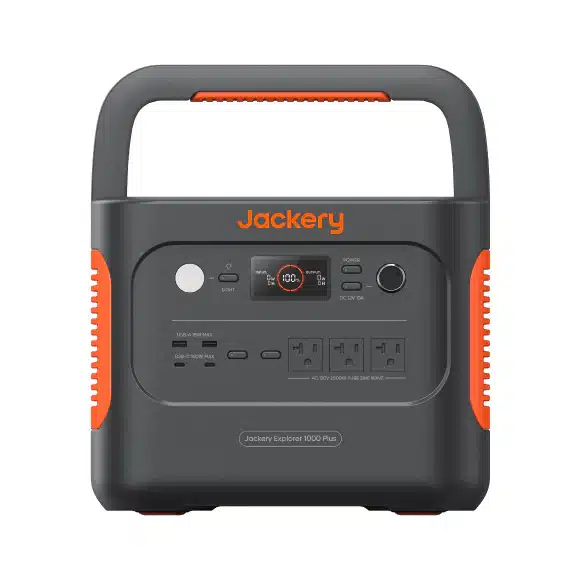
Jackery Explorer 1000 Plus
Jackery’s Explorer 1000 Plus hits a sweet spot for people who want a true midsize power station that’s easy to live with now and can grow later.
You get a 1,264 Wh LFP battery, a 2,000 W pure‑sine inverter, quick AC recharging, and the option to stack up to three add‑on battery packs for roughly 5 kWh total. That combo makes it an affordable gateway into a modular backup system without jumping straight to a heavy, wheeled unit.
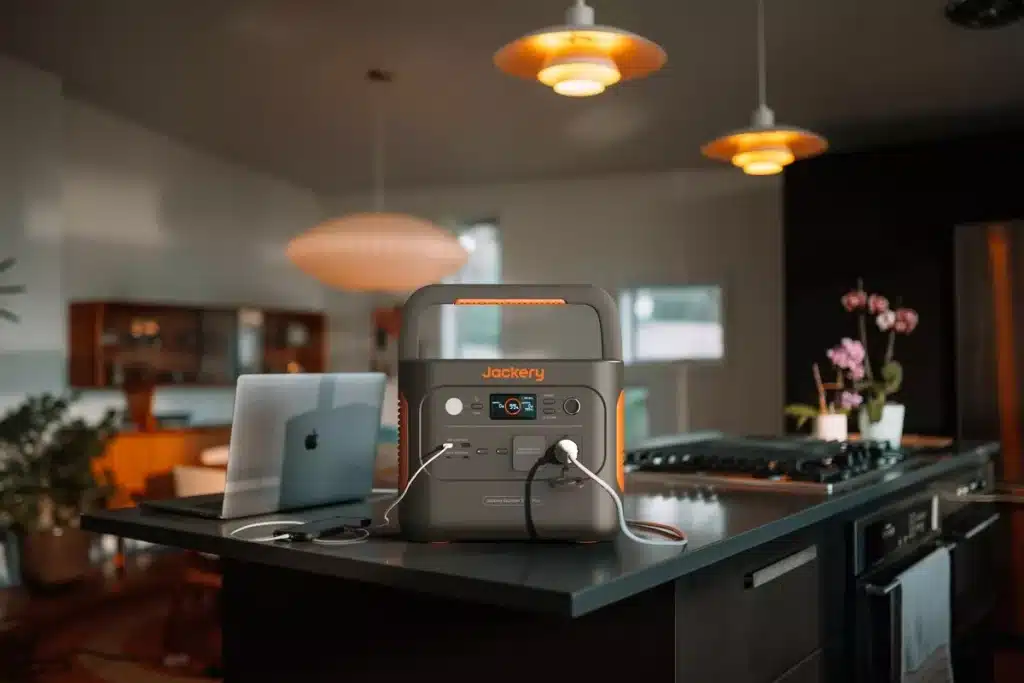
What We Like: You get a strong 2 kW output in a compact class. Three 120 V AC outlets deliver 2,000 W continuous (4,000 W surge), which is unusually muscular for a ~1.2 kWh box. It’ll handle coffee makers, microwaves, shop vacs, and most power tools within reason.
It also allows you to expand up to ~5 kWh. The 1000 Plus accepts up to three 1,264 Wh “Battery Pack 1000 Plus” modules, taking total capacity to about 5,056 Wh. If you only need a portable today but want multi‑day runtime tomorrow, this is how you get there without replacing the base unit.
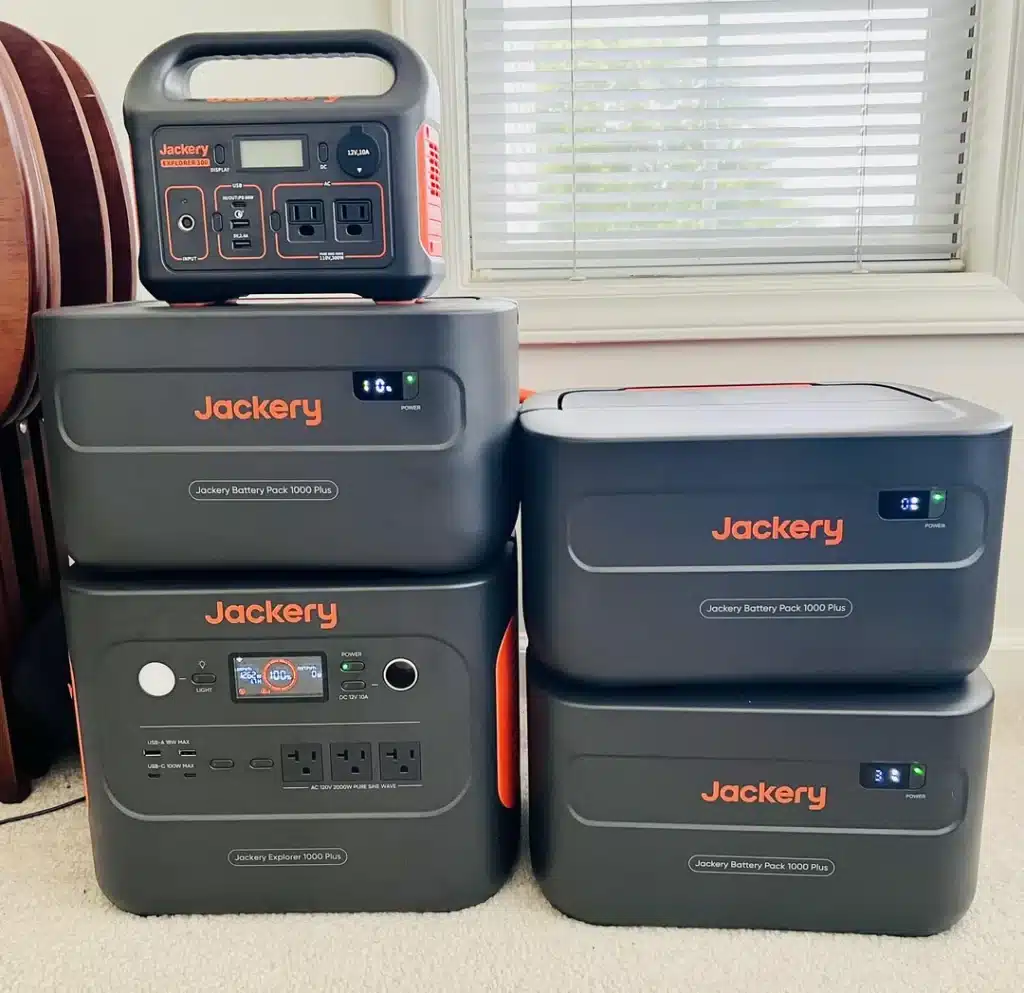
We also like the fast top-ups and flexible inputs. Jackery lists about 1.7 hours from the wall, and the manual shows 1.5 hours with a 1,200 W AC input. You can use two DC solar inputs in parallel (up to 800 W combined), and the unit prioritizes solar when AC and solar are both connected.
It supports pass‑through charging, and its EPS function switches to battery in under 20 ms during brief outages. That’s enough to keep many home electronics alive through a blip. (It’s not a true online UPS, so test your exact setup.)
One of the nice things is the charge mode keeps noise ≤30 dB, so it’s very quiet. The port mix covers most everyday loads: 2× 100 W USB‑C, 2× USB‑A, 12 V car socket, plus the 3× AC outlets. Add to that, the Jackery app adds remote monitoring and charge‑rate control. It’s a lot packed into this product.
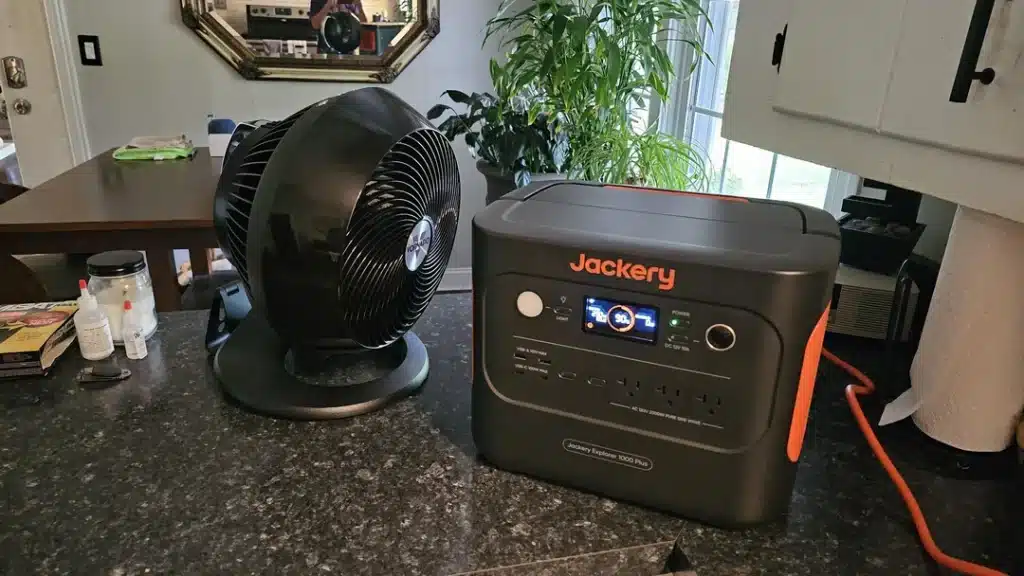
Overall, the pack is rated around 4,000 cycles before it falls to ~80% capacity. While it’s normally available at $999, they offer deals as good as 50% off during holiday sales. That’s a great price for this kind of value.
Flaws but Not Dealbreakers: At 1,264 Wh, heavy appliances drain it quickly. The remedy is obvious but not free: add the 1,264 Wh expansion packs when you need longer runtimes.
Solar is capable but picky about how you wire it. There are two DC8020 inputs that can total 800 W. The manual requires you to match panel counts across the two inputs and warns against stuffing three 100/200 W panels into a single input to avoid over‑voltage. Plan your array accordingly.
Another drawback is that you have to buy into the brand‑centric ecosystem. Jackery advises against third‑party panels and uses its own connectors. Adapters exist, but official guidance is to stick with Jackery panels for support and warranty peace of mind.
Bottom Line: If you want the lowest‑cost way to get a reliable 2,000 W, LiFePO4 power station that can grow into multi‑day backup, the Explorer 1000 Plus is the budget pick. It’s ideal for apartment outages, weekend camping, van duty, and job‑site tools where fast recharging and a clean expansion path matter more than giant built‑in capacity. For most people, this is the best value in an expandable midsize box.
4. BEST MID-SIZE FOR MOST PEOPLE: Anker SOLIX C1000 Gen 2
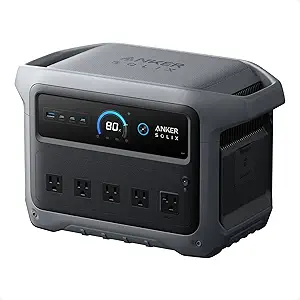
Anker SOLIX C1000 Gen 2
If you want one power station that’s easy to live with, charges fast, and handles real-world loads, the Anker SOLIX C1000 Gen 2 hits the mid-size sweet spot.
You get a 1,024 Wh LFP battery, a 2,000 W inverter (3,000 W peak), a 49‑minute wall recharge when UltraFast charging is enabled in the app, and a 10 ms standby‑UPS mode that keeps small electronics from dropping during blips. It’s compact at 15.1 × 8.2 × 9.6 inches and 24.9 lb, with 10 total ports and up to 600 W of solar input for off‑grid refills.
In short, it’s the best midsize portable power station that hits the sweet spot.
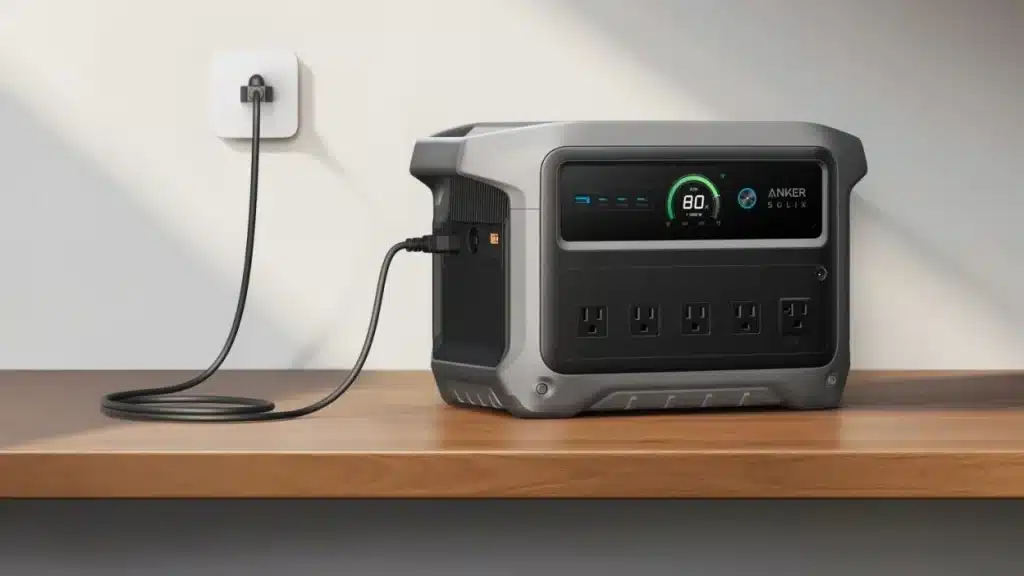
What We Like: You get a full recharge in 49 minutes. The UltraFast “HyperFlash” AC charging pushes up to 1,600 W for a 0–100% refill in roughly 49 minutes. By default it charges at up to 1,200 W, and you can toggle UltraFast in the app when you need a quick turn. That speed is best‑in‑class.
2kW is a lot of output for such a small chassis. The inverter is rated 2,000 W continuous with 3,000 W peak, which covers common home and campsite loads like kettles, coffee makers, space heaters on low, fridges, and shop vacs within reason.
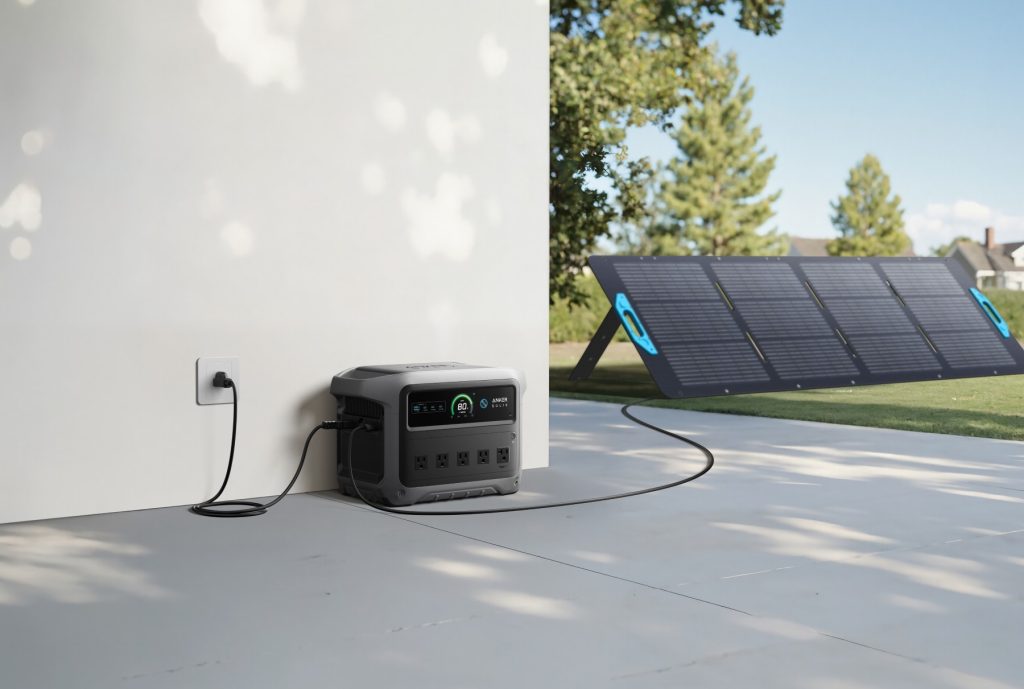
It also has ten ports with high‑watt USB‑C. The port layout is practical: five AC outlets, three USB‑C (two up to 140 W, one 15 W), one USB‑A, and a 12‑V car socket. It will fast‑charge modern laptops over USB‑C without their bricks while still leaving AC outlets for appliances.
Another thing we like is the standby UPS switchover is quoted at 10 ms, quick enough for many routers, NAS boxes, and some desktops not to reboot during a short outage. But treat it like a standby UPS, not an online double‑conversion unit.
Anker rates the pack for 4,000 cycles to 80% with its InfiniPower design. The app adds time‑of‑use scheduling and charge‑limit caps to baby the battery when you’re plugged into grid power.
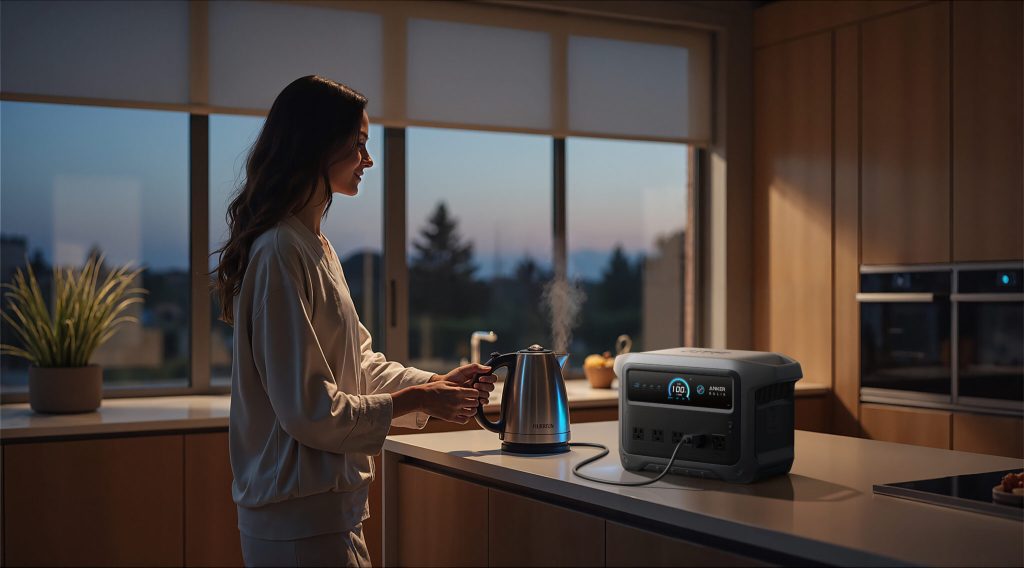
Just to comment on some of the other specs. At 24.9 lb it’s an easy carry for stairs or campsites, and Anker markets the noise level as 20dB. That’s quieter compared to the other models we’ve covered so far. Lastly, a dual‑range MPPT accepts up to 600 W (60 V max), letting you refill from flat in around 1.8 hours of ideal sun with a 600 W array.
Flaws but Not Dealbreakers: The biggest drawback is that it’s not expandable. Unlike the original C1000 (which could add a 1,056 Wh pack), Gen 2 sacrifices expansion to stay smaller and lighter. If you know you’ll need multiday runtime, you’ll want a larger base unit or a modular system.
The solar ceiling is 600 W. That’s solid for a 1 kWh box, but heavier users wanting aggressive daytime refills may prefer models with 800–1,000 W inputs. Plan panel strings to stay within the 11–60 V window.
The last thing I’ll mention is you get only a single USB‑A. Most people will be fine using USB‑C or the AC outlets, but if you live on older peripherals, note the count.
Bottom Line: If you want a mid‑size power station you can actually carry, that charges from empty over lunch, and that can run most household essentials or power‑tool sessions, the Anker SOLIX C1000 Gen 2 is the best pick. It’s ideal for apartment backup, weekend camping, mobile work rigs, and anyone who values fast top‑ups, high‑watt USB‑C, and a simple standby‑UPS mode. If you need expansion batteries or bigger solar, step up a class. For most people, this is the mid‑size to buy in 2025.
5. BEST 2KWH WORKHORSE: BLUETTI AC200L
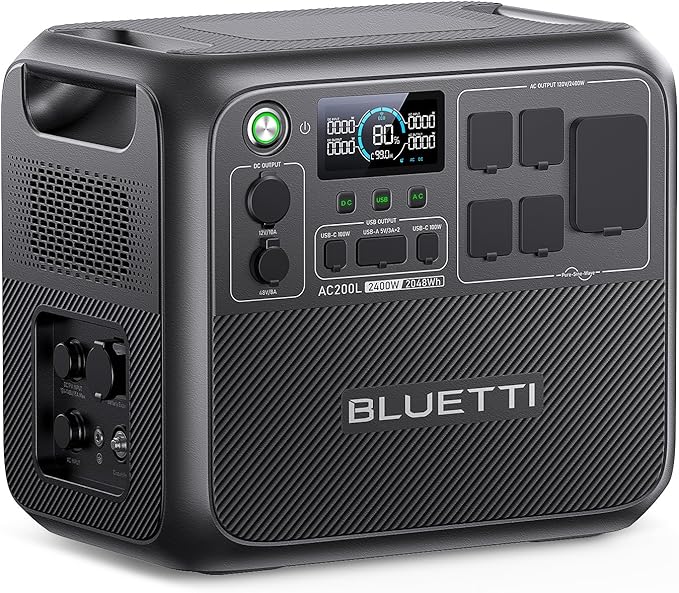
BLUETTI AC200L
If you want a “plug it in, run the house basics, and keep going” box in the 2 kWh class, BLUETTI’s AC200L is one of the best.
It pairs a 2,048 Wh LiFePO₄ battery with a 2,400 W pure‑sine inverter, adds a true RV‑friendly TT‑30 outlet plus high‑watt USB‑C, and then charges from 0–80% in roughly 45 minutes when you need a fast turn.
Solar input climbs to 1,200 W, and a 20 ms standby‑UPS mode keeps small electronics alive through brief blips. Expansion batteries can push total storage to 8,192 Wh, turning this 62‑lb cube into a legitimate multi‑day workhorse.
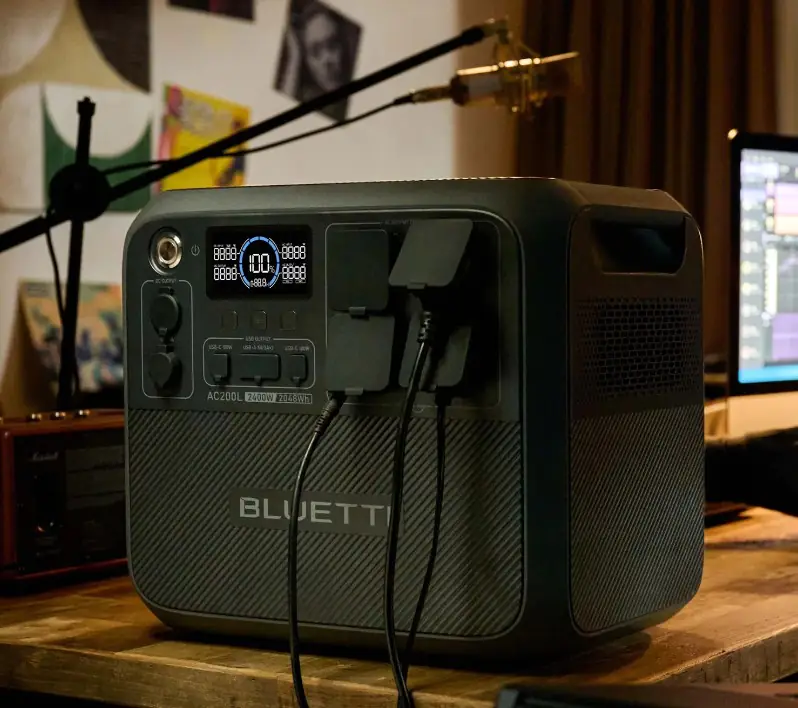
What We Like: One of the first things that stands out to us is this power station offers serious output with headroom. The AC200L delivers 2,400 W continuous AC with a 3,600 W “Power Lifting” mode for certain resistive loads, and BLUETTI lists surge up to 7,200 W. That covers kettles, space heaters on low, fridges, microwaves, shop vacs, and more.
If you enable Turbo in the app, you can refill from 0–80% in about 45 minutes via 2,400 W AC charging. Off‑grid, it accepts up to 1,200 W of solar within a generous 12–145 V window, and it allows AC + solar for a combined 2,400 W max input.
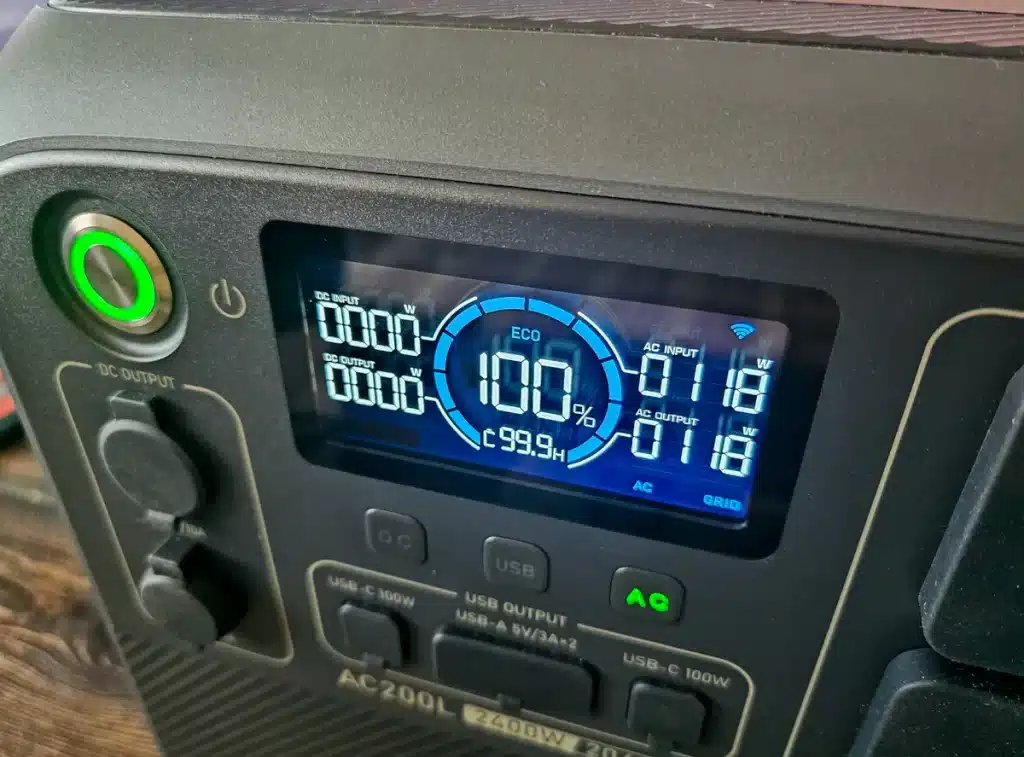
You get eleven total outputs: four 120 V/20 A household outlets, one 120 V/30 A TT‑30 for RVs, two 100 W USB‑C, two 18 W USB‑A, a regulated 12 V/10 A car socket, and a 48 V/8 A DC port for RV house batteries (with BLUETTI’s D40 regulator). Essentially, it can go straight to an RV shore‑power cord.
Also, you can expand without changing the base unit. You can start at 2,048 Wh and grow to 8,192 Wh by adding expansion batteries: up to two B300 packs, or two B210 packs, or one B230. Hot‑swap support means you can keep working while you switch packs.
Another thing to mention – no bulky external brick; the AC200L’s charger is internal. You get Bluetooth and Wi‑Fi control, charge‑rate scheduling, and low‑noise charge modes for indoor use.

More from CAT Outdoors:
Flaws but Not Dealbreakers: They market it as portable, but at 62.4lbs, it’s pretty heavy. It’s more of a two‑hand carry, and more of an at home-on-a-dolly than in a backpack.
Switchover is quoted at ~20 ms. Like most power stations, it’s a standby EPS/UPS. Sensitive PC PSUs can still hiccup, so verify your workload before relying on it.
BLUETTI replaced the old high‑amp 12 V output with a 48 V/8 A port. It’s fantastic for RV house batteries with the D40 regulator, but if you wanted a native high‑amp 12 V output, factor in adapters.
Lastly, there’s no split‑phase or unit‑to‑unit pairing. You cannot bond two AC200Ls for 240 V split phase. If you need true 240 V or whole‑home circuits, look higher in BLUETTI’s lineup.
Bottom Line: If you want a 2 kWh class power station that hits hard, refills fast, and scales into multi‑day backup without ditching the base unit, the AC200L is the practical pick. It shines for home backup, RVs with a TT‑30, job‑site tools, and cabin use with meaningful solar. Skip it only if you need split‑phase 240 V, a featherweight form factor, or you’re locked into a 12 V high‑amp accessory ecosystem. For most “workhorse” needs, this is the 2 kWh box we’d recommend.
6. BEST RV/VANLIFE PICK: Anker SOLIX F2000 (PowerHouse 767)
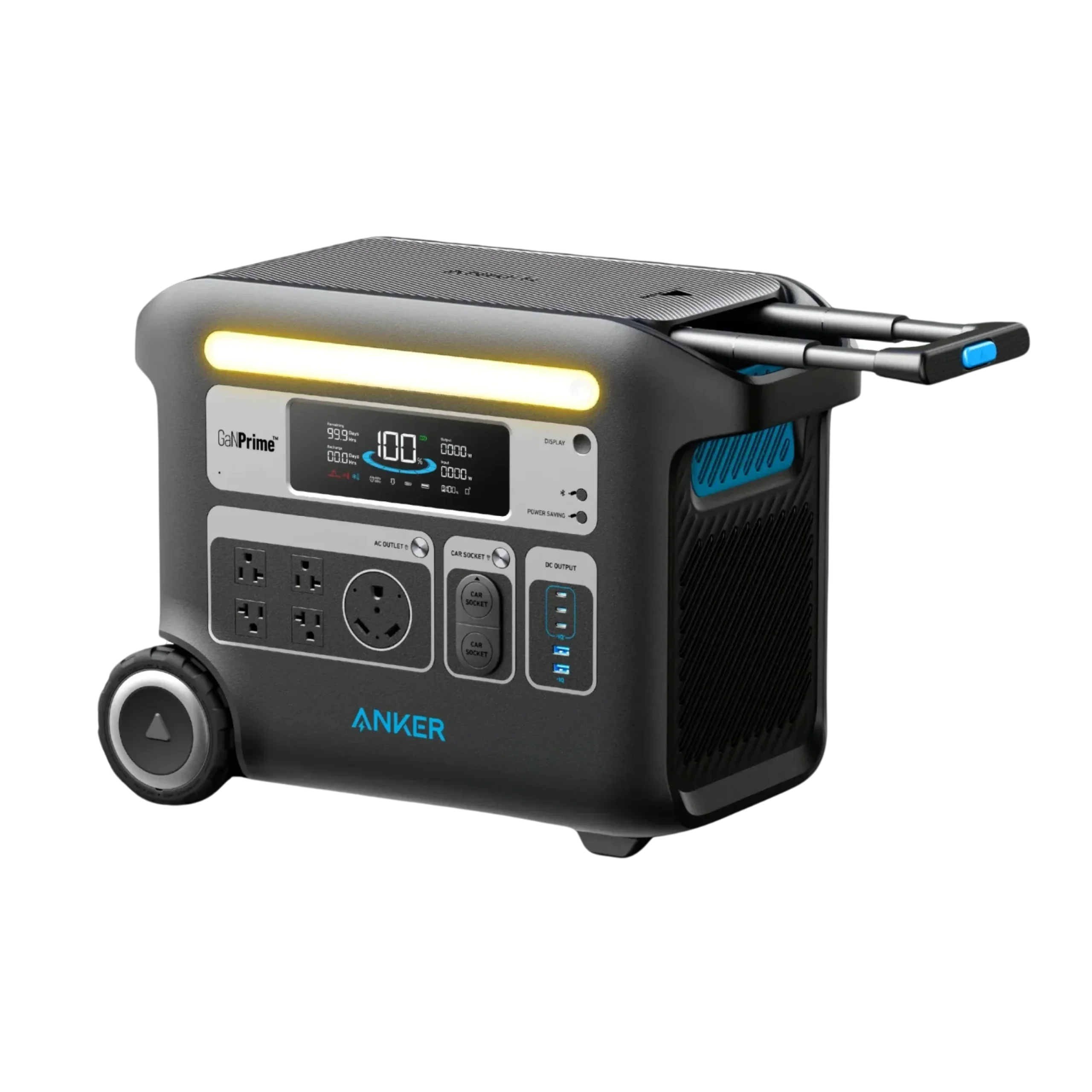
Anker SOLIX F2000
Built like a rolling suitcase with serious power inside, the SOLIX F2000 is Anker’s road‑trip workhorse. You get a 2,048 Wh LFP battery, a 2,400 W pure‑sine inverter, up to 1,000 W of solar input, and a 5‑year full‑device warranty.
The chassis rides on large wheels with a retractable “EasyTow” handle, and there’s a dedicated 30‑amp RV outlet plus 12 total ports. If you need more runtime, add the expansion battery to double capacity to 4,096 Wh. That checklist makes it a standout for vans, trailers, and mobile studios.
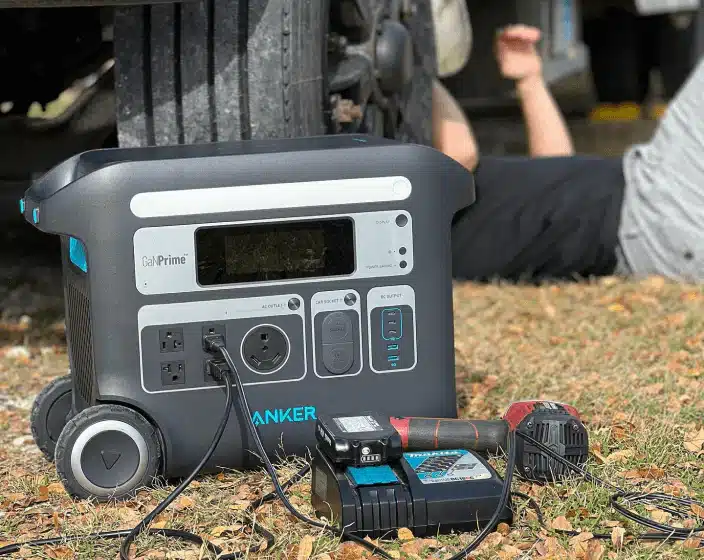
What We Like: The F2000 is RV‑ready I/O. A true RV‑style 120 V/30 A TT‑30 outlet lets you plug in like shore power, and the overall port mix covers most rigs: four standard AC outlets, the TT‑30, three USB‑C (up to 100 W each), two USB‑A, and two 12 V “car” sockets. It’s the right combination for an RV panel plus laptops, cameras, and a 12 V fridge.
At roughly 67 lb, lift‑and‑carry is a two‑hand job. But it has big 4.72‑inch wheels and a retractable handle that make moving it around campsites, garages, and parking lots painless. For vanlife, it makes life a lot easier.
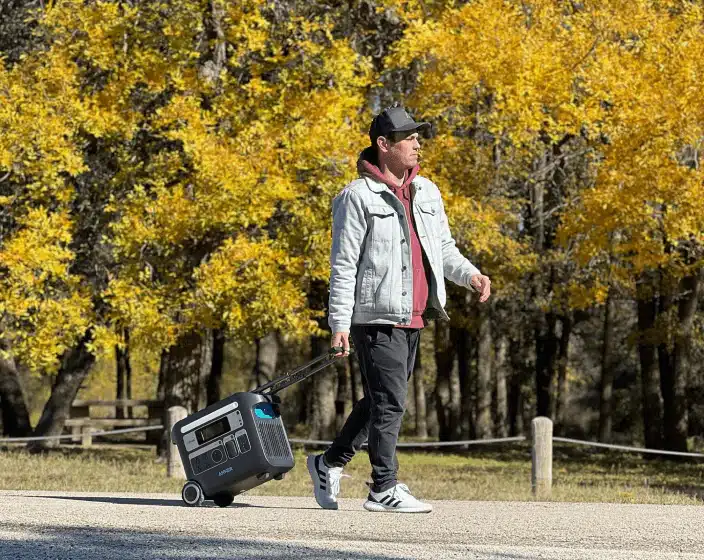
Recharges are fast and simple. The included 1,440 W AC cable enables quick top‑ups, which specs around 80% in ~1.4 hours and full in ~2.5 hours. No external power brick to wrangle.
You can also power with solar. An MPPT input accepts up to 1,000 W (11–60 V, current‑limited by voltage range), so a pair of folding 400 W panels plus a roof panel can refill between camps.
You also have the option to expand for longer trips. If you add the BP2000/760 expansion pack you can double capacity to 4.096 kWh without changing the base unit. That’s enough to stretch multi‑day boondocking between sunny charges.
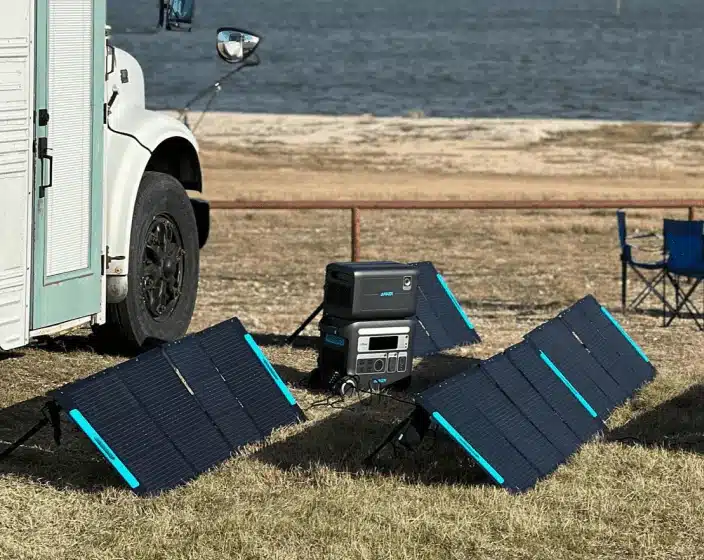
EV‑grade LiFePO₄ cells are rated for about 3,000 cycles to 80% capacity, and perhaps the best feature is that Anker backs the F2000 with a 5‑year full‑device warranty.
Flaws but Not Dealbreakers: It’s heavy. The wheels help, but 67 lb is still a lot to lift into a van solo. Plan to roll it when you can and save the deadlifts for the gym.
Another drawback is that you get one‑battery expansion only. The max capacity tops out at 4,096 Wh with a single expansion pack. If you know you’ll want 6–8 kWh or split‑phase 240 V later, you’ll need a larger, more modular system.
The solar wiring details will matter. The spec allows 11–60 V; push too low and you’ll current‑limit, too high and you’re out of range. Plan panel strings for that window to hit the full 1,000 W.
Lastly, is that it’s U.S.‑only TT‑30. The RV outlet is on U.S. models; other regions get different AC layouts. Double‑check your SKU before buying.
Bottom Line: For RVs, vans, and mobile creators who want good AC power, quick recharges, and a port layout made for life on the move, the Anker SOLIX F2000 is our top recommendation. Roll it into place, plug in via TT‑30, and top up fast from shore power or meaningful solar. If you need multi‑battery expansion or 240 V split phase, look upmarket; for most rolling setups, this strikes the best balance of output, portability, and price.
7. BEST WEATHER‑RESISTANT: BLUETTI AC240
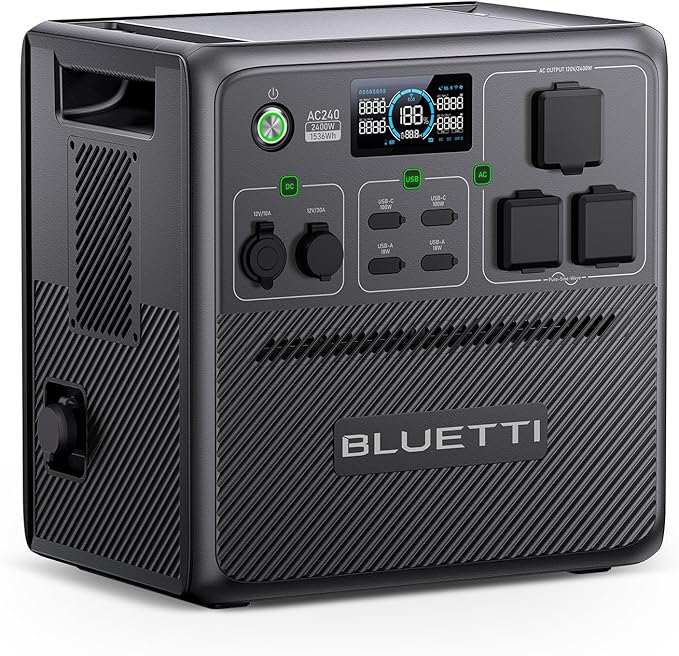
BLUETTI AC240
If your power station will live outdoors, ride in the bed of a truck, or sit on a damp dock, the BLUETTI AC240 is the safest bet. It’s a 1,536 Wh LiFePO₄ unit with a 2,400 W pure‑sine inverter and a true IP65 enclosure that shrugs off dust and low‑pressure water jets.
It fast‑charges to 80% in about 45 minutes on AC, takes up to 1,200 W of solar, and can scale to 10,136 Wh with add‑on batteries. In short, it’s built for bad weather and rough handling without giving up serious capability.
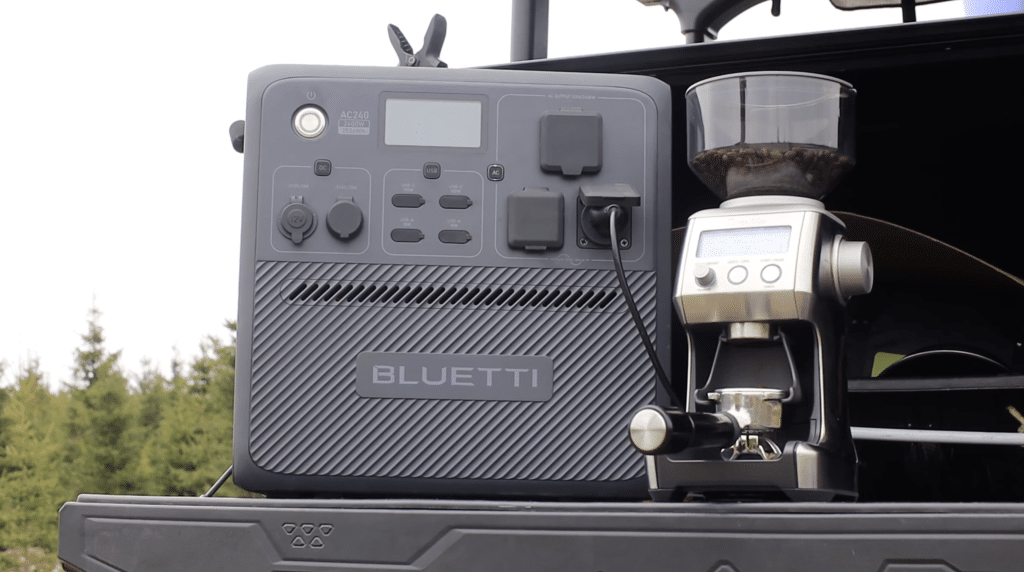
What We Like: The IP65 rating is the headline: sealed against dust and resistant to water jets from any direction. Port covers and gaskets are designed to maintain that seal. For campsites, boats, and job sites where things get wet or gritty, it’s the best on the market.
You still get a strong output and practical port mix. It has 2,400 W continuous AC with a 3,600 W “Power Lifting” mode for certain resistive loads. Outputs include two 120 V/20 A outlets, a 120 V/30 A TT‑30 for RVs, two 100 W USB‑C, two USB‑A, a 12 V/10 A “car” socket, and a 12 V/30 A RV/DC port.
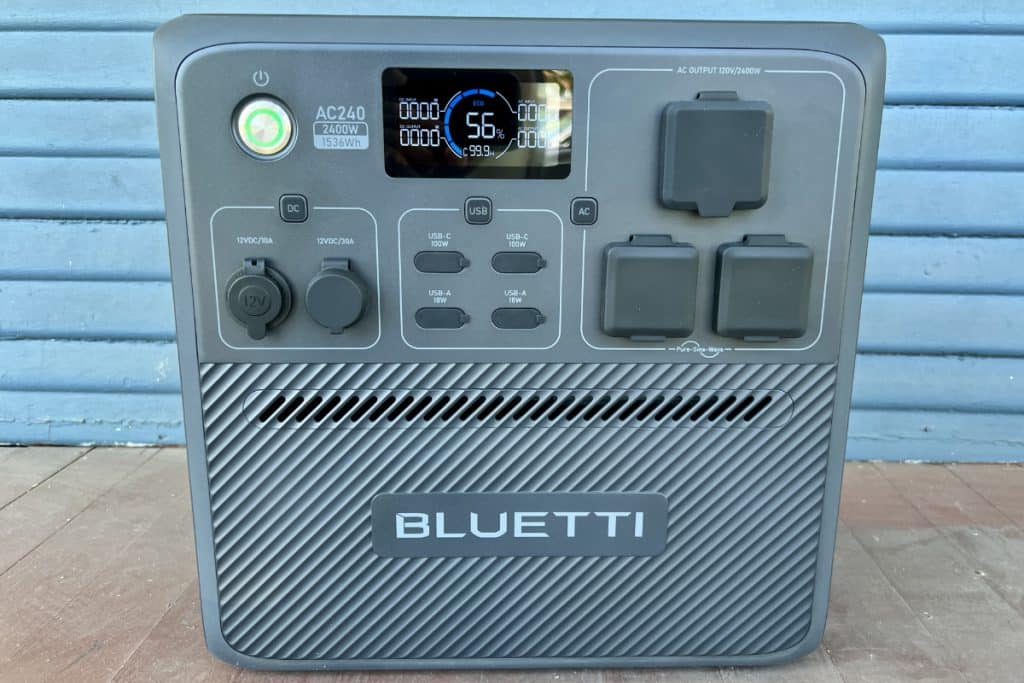
AC charging can hit 0–80% in about 45 minutes (0–100% ~70 minutes) in Turbo mode; solar input reaches 1,200 W within an 11–60 V window. Car charging and shore‑power options are supported as well.
It has really nice expandability. You can add up to four B210 expansion batteries to reach 10,136 Wh. Two AC240s can be paralleled for up to 4,800 W at 120 V with the P480 kit. And the B210 packs are IP65, too, and even include their own USB ports. Switchover is quoted at 15 ms, which should be good for keeping routers, NAS boxes, and similar gear alive through brief blips.
Lastly, the service life is good. The LFP pack is rated for 3,500+ cycles and carries a 6‑year warranty.
Flaws but Not Dealbreakers: That main thing is “weather‑resistant” doesn’t mean “use it in the rain.” IP65 resists water jets, but BLUETTI explicitly says the AC240 isn’t waterproof and shouldn’t be used in the rain. If the ports get wet, dry them before use. Treat it as storm‑tolerant storage, not as an all‑weather outlet you can run while it’s wet.
It’s better as a set‑and‑forget box than something you move every day. At about 72lbs, it’s pretty heavy. If you need wheels, consider a wheeled model.
The max 2,200 W AC input (2,400 W when paired with B210) requires a separate high‑amp cable. Not a dealbreaker, but note the extra accessory.
BLUETTI’s use proprietary AC/DC connectors and has limited availability of the P480 parallel kit in some regions. If you misplace a cable, you may need BLUETTI‑specific replacements.
Bottom Line: If you need a power station that can live outside and still deliver real AC power, the BLUETTI AC240 is what we’d recommend. It’s ideal for salty docks, dusty job sites, overland rigs, and cabins where a storm‑ready enclosure matters as much as wattage. If you want something lighter or you’re chasing split‑phase 240 V, look elsewhere. For weather resistance plus genuinely useful performance and expansion, this is the best choice right now.
8. BEST HOME BACKUP ON WHEELS: EcoFlow DELTA Pro 3
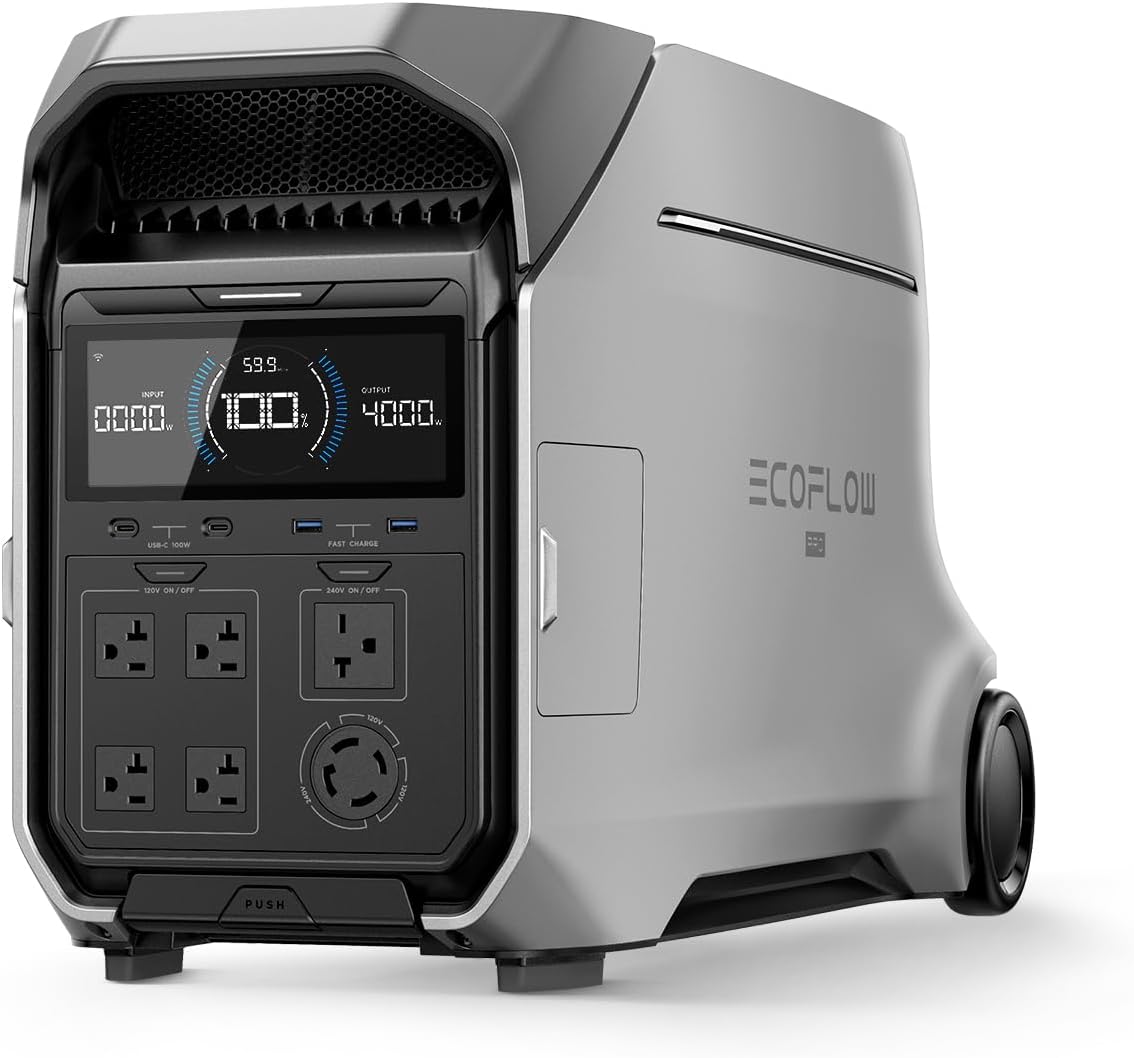
EcoFlow DELTA Pro 3
DELTA Pro 3 is EcoFlow’s “bring‑it‑anywhere, power‑the‑house” flagship on wheels. You get a 4,096 Wh LiFePO₄ pack, a 4,000 W pure‑sine inverter, native 120 V or 240 V output from the same unit, and a 10 ms standby‑UPS mode that keeps sensitive gear alive through blips.
It’s built to roll with integrated wheels and a pull handle, yet it ties into home circuits via an inlet or EcoFlow’s Smart Home Panel 2 for whole‑home backup. In short, it’s the most portable way to cover household loads.
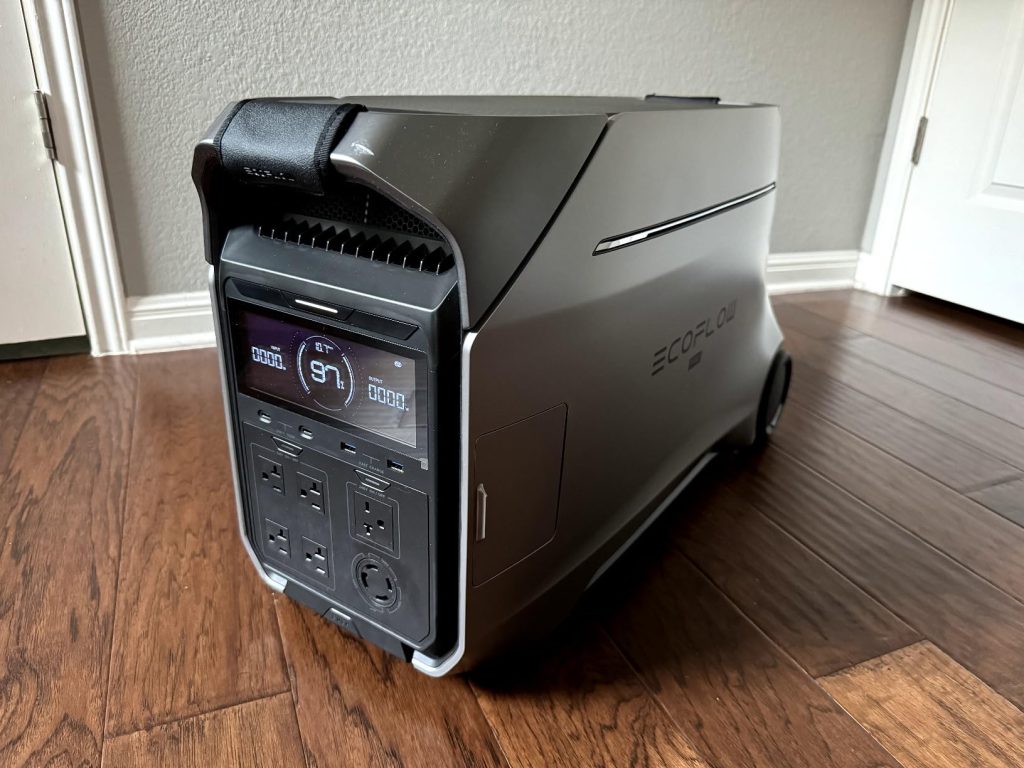
What We Like: It offers 120/240 V from one box. Simply press a button to choose between 120 V or split‑phase 240 V.
In 120 V mode you get four 20 A outlets plus a TT‑30 for RVs; in 240 V mode there’s a 6‑20R and a locking L14‑30 that can feed a transfer/inlet box. Continuous output is 4,000 W with 8,000 W surge, so fridges, microwaves, well pumps, and many window A/Cs are fair game.
Two PV inputs accept up to 2,600 W total: a high‑voltage MPPT (30–150 V, 1,600 W max) and a low‑voltage MPPT (11–60 V, 1,000 W max). AC charging is plug‑and‑play; for true Level‑2 style rates up to 4,000 W you can use EcoFlow’s EV X‑Stream adapter on the AC in/out port.
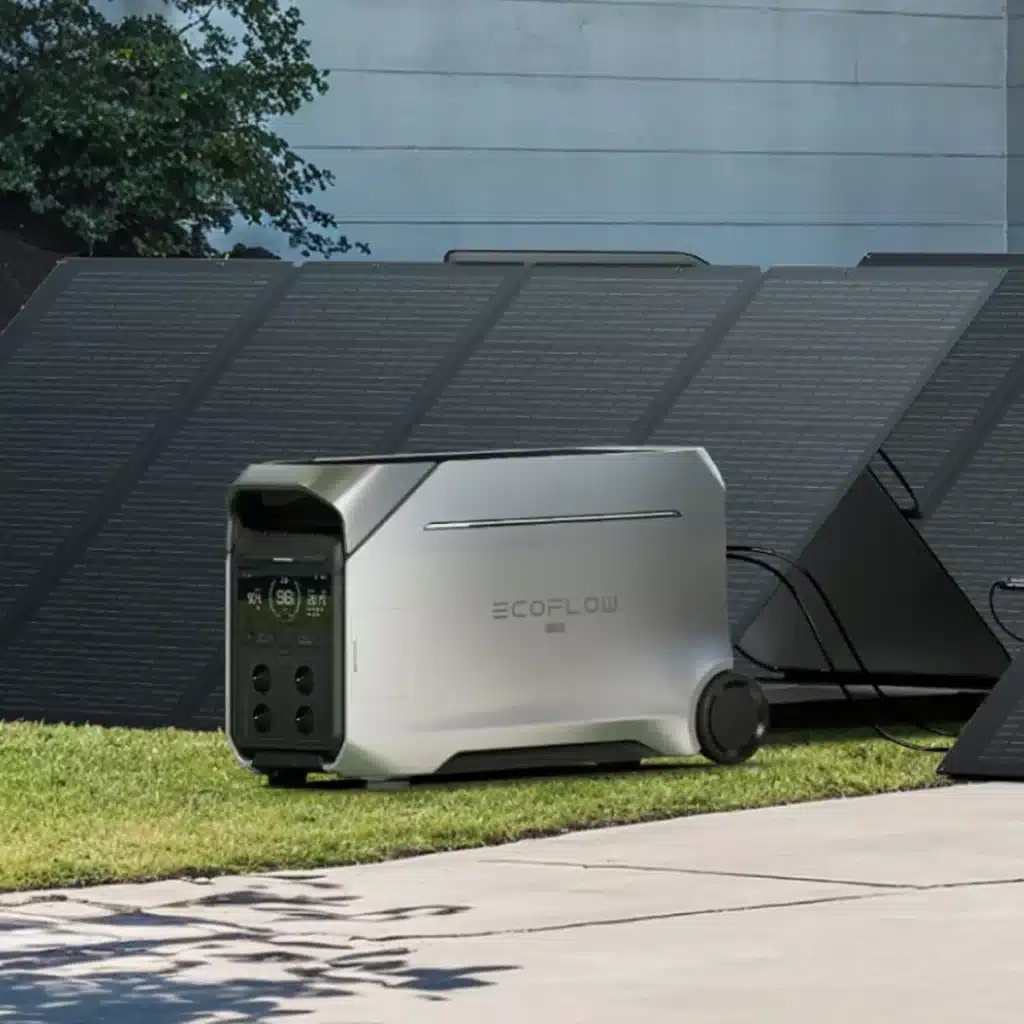
Essentially, the power station makes your home‑backup ready without a permanent install. Roll it to an inlet and use the built‑in L14‑30, or integrate up to three DELTA Pro 3s with Smart Home Panel 2 for managed circuits, app control, and system output up to 12 kW. Switchover is quoted at ~10 ms (the lowest on this list).
You can scale a single unit from 4.096 kWh up to 12 kWh by stacking two Extra Batteries. As a system with three inverters and expansion packs, EcoFlow quotes up to 36 kWh (and more with a Smart Generator). That’s serious runway for extended outages.
EcoFlow also touts very low noise under moderate loads (~30 dB) and a 5‑year warranty on the power station.
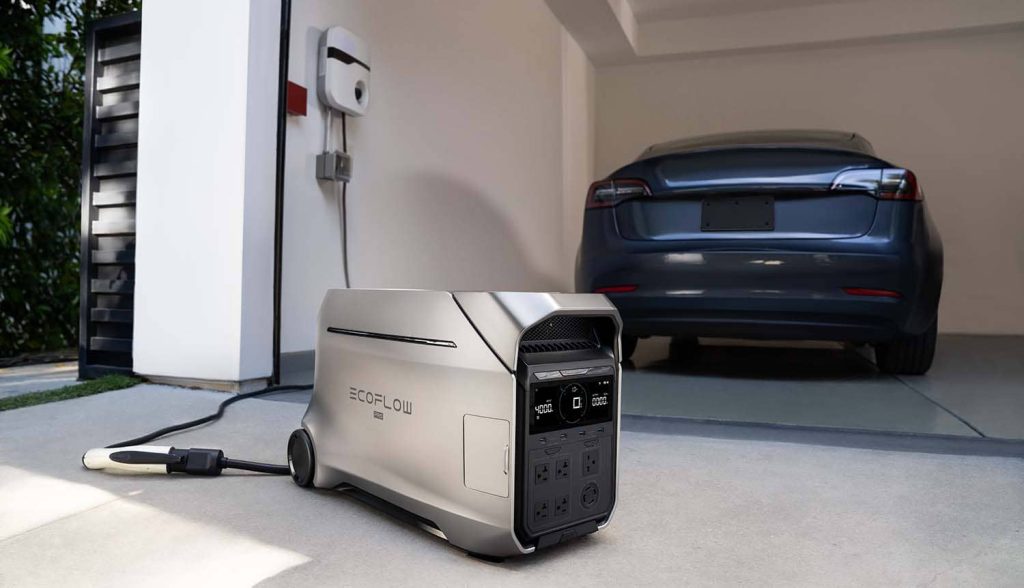
Last note on the DELTA Pro 3. The battery is rated for 4,000 cycles to 80% capacity. The battery module itself carries an IP65 rating for dust/water‑spray resistance, so it is water-resistant, but you should avoid baptizing it in the lake. Also, the unit offers internal GFCI support plus app‑configurable external‑GFCI compatibility.
Flaws but Not Dealbreakers: It’s quite heavy, but the wheels and telescoping handle make the 113.5 lb chassis manageable around the house or garage. If you’re going up a flight of stairs, plan on needing help.
The 120 V and 240 V aren’t simultaneous. You can select one or the other. Mixed‑voltage homes may want an inlet feeding a small critical‑loads panel or the Smart Home Panel 2 so you can choose which branch circuits get power.
The fastest AC charging needs an accessory. The built‑in grid input on U.S. units is effectively Level‑1. For Level‑2‑like 240 V, 4,000 W charging you’ll need EcoFlow’s EV X‑Stream adapter for the AC in/out port. Budget accordingly.
Beware the IP rating. The battery pack is IP65, but the main chassis is rated IP20 and should be used indoors or in sheltered locations. Don’t operate it in rain.
Lastly, the DELTA Pro 3 works with Smart Home Panel 2, DP3 Extra Batteries, and select accessories, but it can’t be paralleled with a first‑gen DELTA Pro or the DELTA Pro Ultra main unit. We’d recommend you check your mix before buying.
Bottom Line: If you want whole‑home‑style backup that can literally roll to wherever you need it, DELTA Pro 3 is the best wheeled option right now. It delivers true 120/240 V output, meaningful surge headroom, fast solar and AC refills, and a clean path to managed circuits with Smart Home Panel 2. Choose it for houses or townhomes where you can’t install a permanent generator, for “portable” backup between properties, or as a mobile power cart that still integrates with the home when the grid goes dark.
9. MOST RUGGED BIG‑BATTERY ALTERNATIVE: Goal Zero Yeti PRO 4000
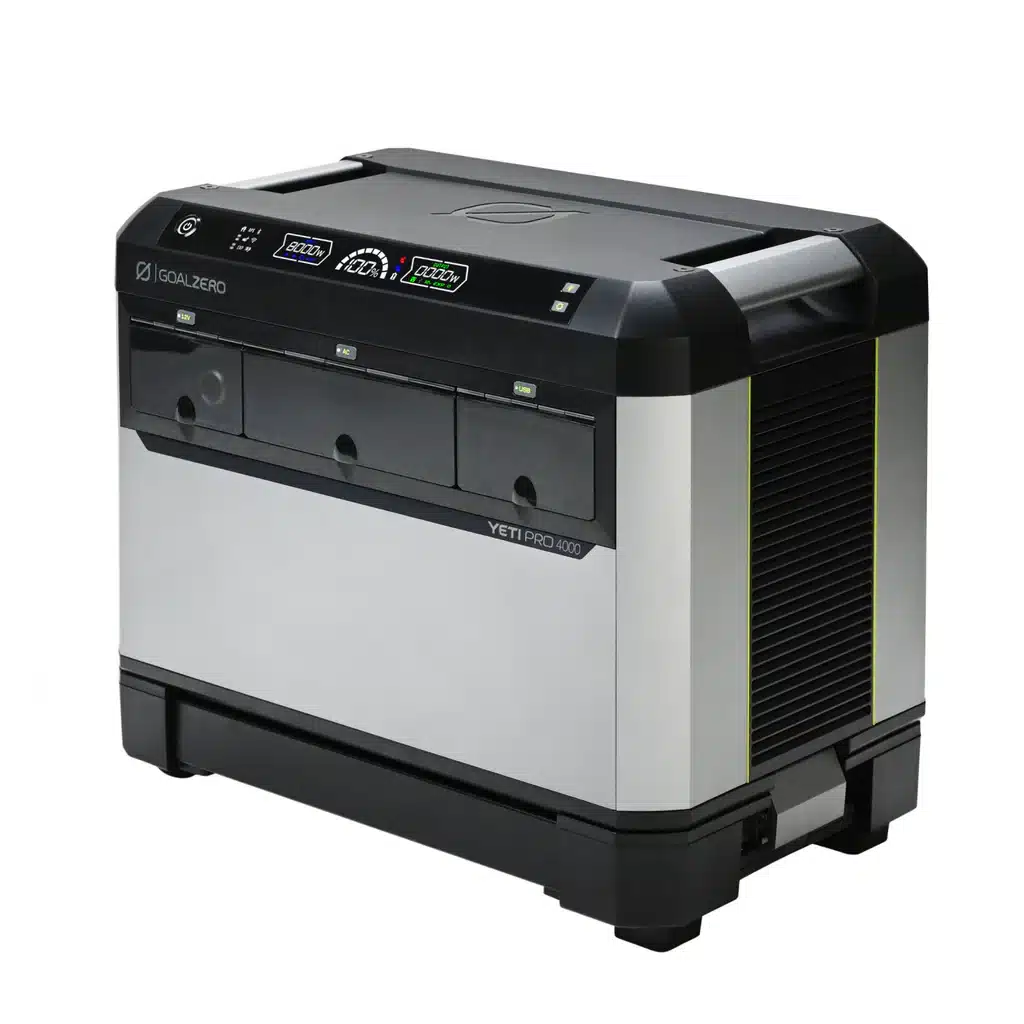
Goal Zero Yeti PRO 4000
If you want a 4 kWh class unit that can live in the garage, roll into the yard, or ride to a job site without babying it, Goal Zero’s Yeti PRO 4000 is that guy. You get a 3,994 Wh LiFePO₄ battery, a 3,600 W pure‑sine inverter with 7,200 W surge, very fast AC and solar recharging, and an ecosystem that ties into home circuits or van builds.
It can take a lot of abuse, is outdoor‑use rated, and has a removable wheeled cart to actually move the thing.
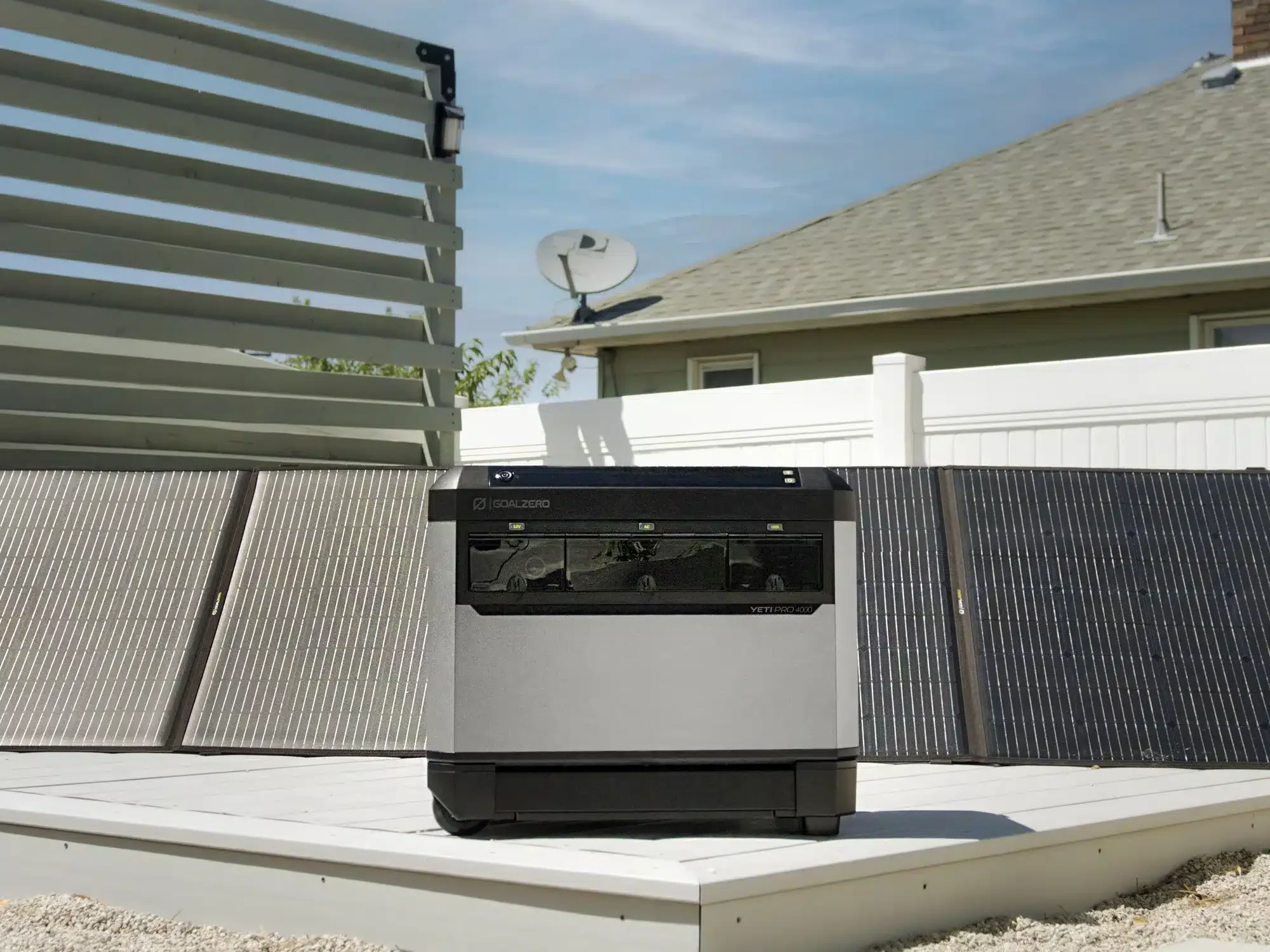
What We Like: The Yeti PRO 4000 is rated for portable outdoor use and carries UL 2743 and IPX3 certifications, plus it passes MIL‑STD‑810H vibration testing. Translation: rain splash and rough rides aren’t a deal‑breaker.
It packs a lot of power. The inverter delivers 3,600 W continuous and 7,200 W surge, with a dedicated 30‑amp RV TT‑30 outlet alongside four 20‑amp household outlets. That’s enough for fridges, microwaves, space heaters on low, and most power tools within reason.
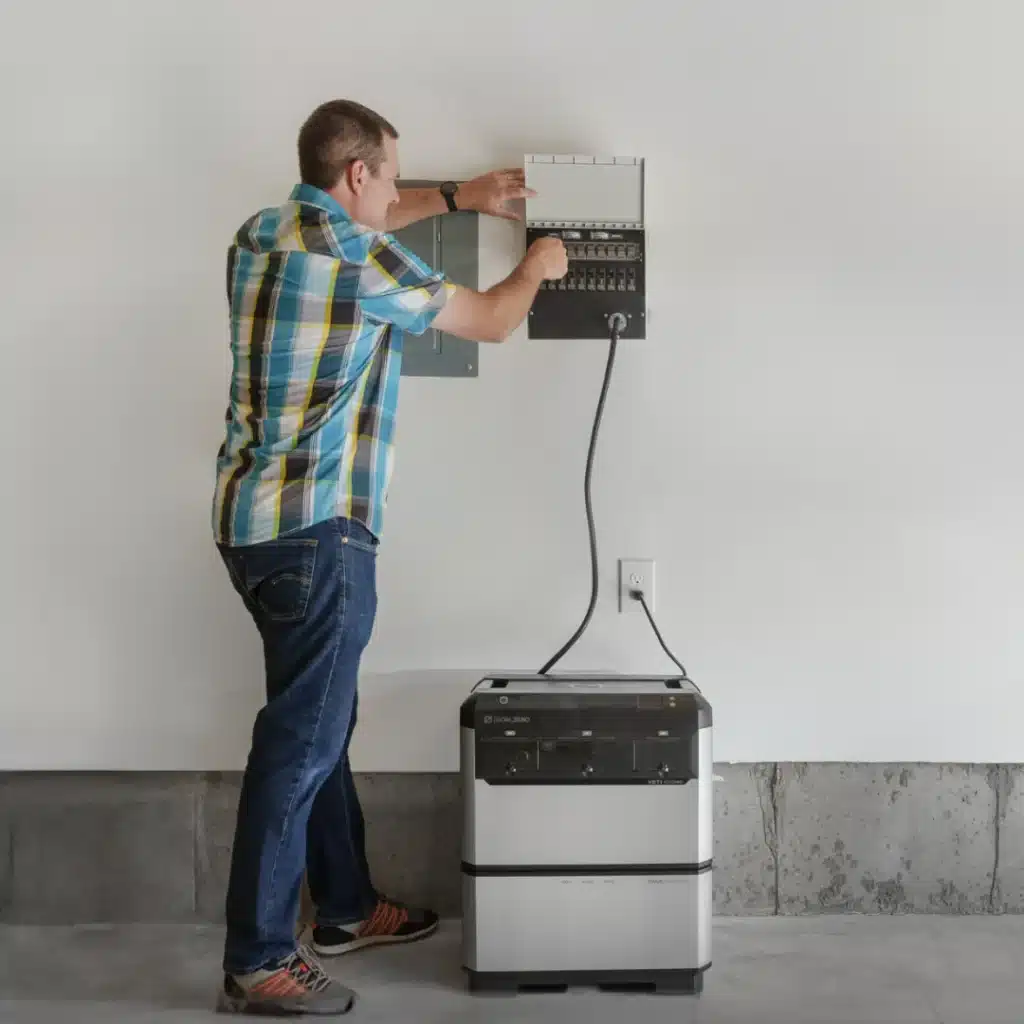
What stands out to us is how quickly a unit this big can be recharged. The AC “fast charge” brings the pack from 0–80% in about 2 hours, and the high‑voltage MPPT input accepts up to 3,000 W of solar for 0–80% in roughly 90 minutes in ideal sun. Few big‑battery boxes charge this quickly.
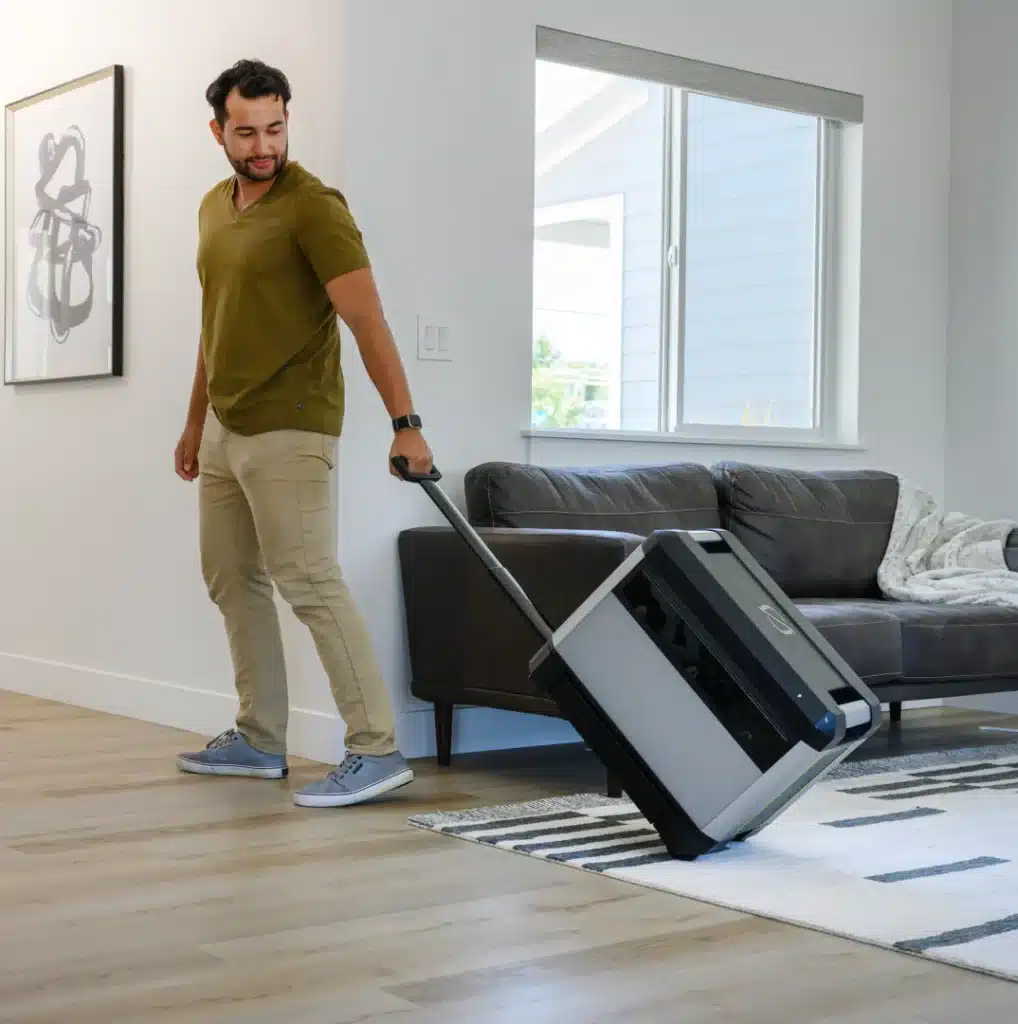
A removable roll cart with integrated wheels and pull handle make is ultra portable, making the 100‑plus‑pound chassis manageable around the house or campsite.
Add up to four Tank PRO 4000 expansion batteries to reach as much as 20 kWh of storage. Pair it with Goal Zero’s Haven 10 transfer switch to back up as many as ten household circuits.
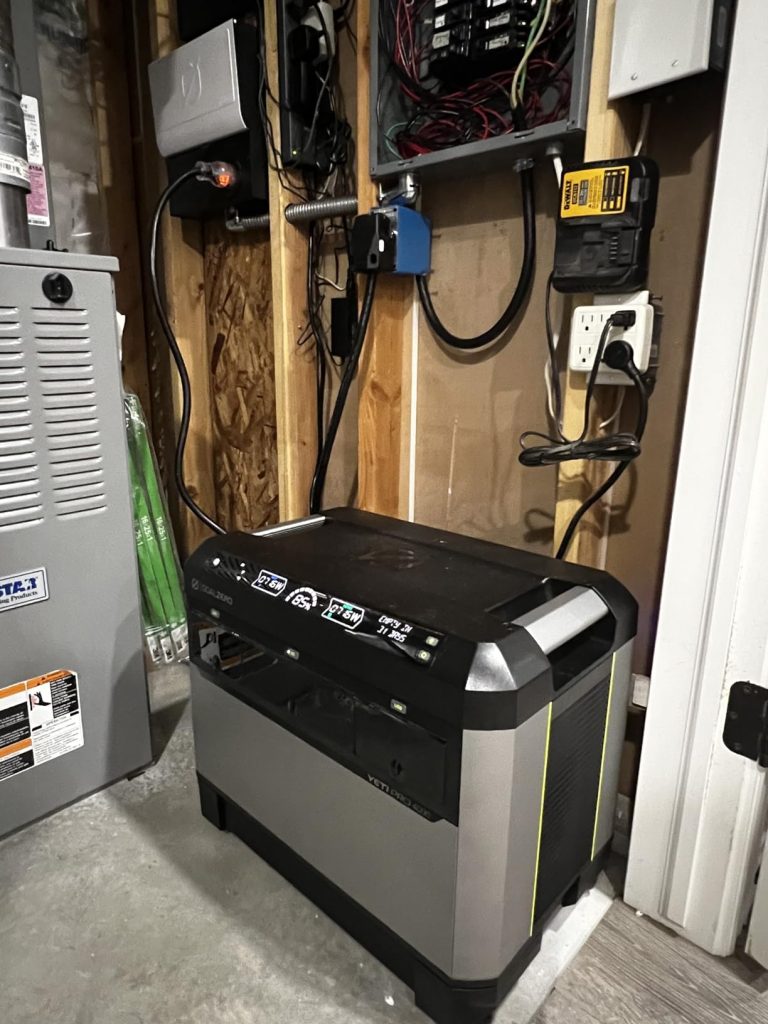
Beyond AC, you get three USB‑A, three USB‑C (one at 100 W), regulated 12 V outputs including a 30‑amp high‑power port, plus Wi‑Fi/Bluetooth control in the Goal Zero app. Also, the LiFePO₄ cells are rated for 4,000+ cycles and the unit carries a 5‑year warranty, which is strong for a portable in this class.
Flaws but Not Dealbreakers: First thing that stands out to us is unlike some competitors, the Yeti PRO 4000 does not output split‑phase 240 V. The Haven 10 integrates neatly, but it’s designed for up to ten 120‑V circuits only. If you must power 240‑V loads, consider a different platform.
Base weight is roughly 116 lb (about 126 lb on the cart). You’ll roll it, not lift it — plan for ramps or a buddy if stairs are involved. The 3,000 W solar input uses Goal Zero’s high‑power port and a 13.3–150 V range. It’s great once set up, but plan strings and cabling to fit their ecosystem.
Additionally, the “Fast AC” tops out at 1,800 W. Wall charging is quick, but the unit doesn’t natively support ultra‑high‑watt Level‑2‑style AC inputs like some rivals do via special adapters. If ultra‑fast AC charging is a must, compare specs closely.
Bottom Line: If you want a big‑battery power station that’s durable, charges fast, rolls where you need it, and plugs into a tidy home‑backup or van install, the Goal Zero Yeti PRO 4000 is gonna be hard to beat. Skip it if you require native 240 V output or featherweight portability. But for storm season, job sites, cabins, and road rigs where durability matters as much as watts, this is our top pick.
FINAL THOUGHTS ON THE BEST PORTABLE POWER STATIONS
There you have our picks for the best portable power stations!
Whether you need a compact unit for camping, a midsize backup for the house, or a monster setup on wheels that can run a fridge and power tools, there’s something on this list that fits your life and loadout.
For all-around performance, EcoFlow’s DELTA 3 Plus nails the balance of power, speed, and expandability. The Anker SOLIX C1000 Gen 2 is the one you’ll actually carry and use every day.
If you need a true workhorse, the BLUETTI AC200L pulls double duty for home and field, while the Jackery Explorer 1000 Plus proves you don’t need to spend big to get serious reliability.
For RVs and road warriors, Anker’s F2000 PowerHouse is a rolling power hub that just works.
And when it comes to ruggedness, the Goal Zero Yeti PRO 4000 and BLUETTI AC240 are built for weather, dust, and punishment.
Got a favorite power station that didn’t make the list? Or a model that left you in the dark at the worst possible time? Drop a comment below — I want to hear what’s powering your world.

Justin Trump is the managing editor and owner of CAT Outdoors. The son of a Vietnam veteran, he’s a Certified Glock Armorer, an avid gun enthusiast and 2A advocate. He holds two firearm patents for the CAT M4 and Talon tools. When not managing CAT Outdoors, he enjoys spending time with his family and friends, rooting for Michigan sports teams, and serving his church.

